- Home
-
SHOP ECO FARM
- ECO Farm Grow Lights
- ECO Farm LED Grow Lights
- ECO Farm Quantum Board
- ECO Farm Samsung LED Grow Lights
- ECO Farm COB Grow Lights
- ECO Farm Commercial Lights
- ECO Farm Supplemental Grow Light
- ECO Farm Fluorescent grow lights
- ECO Farm HPS & MH Grow Lights
- ECO Farm CMH Grow Lights
- ECO Farm HID/CMH Bulbs & Ballasts
- ECO Farm Grow Tents & Kits
- ECO Farm 2x2ft Grow Kits
- ECO Farm 3x3ft Grow Kits
- ECO Farm 3.3x3.3ft Grow Kits
- ECO Farm 4x4ft Grow Kits
- ECO Farm 5x5ft Grow Kits
- ECO Farm Grow Tent - Standard Style
- ECO Farm Grow Tent - Extension & Roof & Lodge Style
- ECO Farm Extraction & Harvest
- ECO Farm Rosin Press Machine
- ECO Farm Dry & Wet Trimmers
- ECO Farm Oil Accessories
- ECO Farm Medicinal Plants Grinder
- ECO Farm Medicinal Plants Containers
- ECO Farm Medicinal Plants Dryer
- ECO Farm Refrigeration Dryer
- ECO Farm Climate Control & Other Accessories
- ECO Farm Inline Duct Fans
- ECO Farm Oscillating Fans
- ECO Farm Exhaust Fans
- ECO Farm Air Filter
- ECO Farm Duct Muffler
- ECO Farm Ventilation Kits
- ECO Farm Plant Humidifiers
- ECO Farm Plant Dehumidifiers
- ECO Farm Hydroponic Accessories
- ECO Farm Other Accessories
- ECO Farm Hydroponics Microscopes
-
TOP BRANDS
- Grow Lights Brands
- Adjust-A-Wing
- Apollo Horticulture
- Bestva
- Black Dog LED
- California Lightworks
- ChilLED Grow Light
- Eco Farm
- HLG - Horticulture Lighting Group
- Kingled
- Kind LED
- Mars Hydro
- Morsen
- Neilo
- NextLight
- Phlizon
- PlatinumLed
- Roleadro
- Optic LED Grow Lights
- ViparSpectra
- Vivosun
- EYE Hortilux
- IPOWER
- NanoLux
- Phantom grow light
- Gavita grow lights
- Grower's Choice
- Lumatek
- Maxibright
- Yearld Pro
- ThinkGrow
- Crecer Lighting
- Green Sunshine Electric Sky
- fohse aries
- loriflux
- luxx
- fluence
- iluminar
- Lex
- LTC
- Rayonled
- FGI
- PHOTONTEK
- Grow Tents & Kits Brands
- Apollo Horticulture
- Black Box
- CoolGrows
- Eco Farm
- GrowLab
- Gorilla Grow Tents
- Mars Hydro
- Quictent
- Secret Jardin
- Unit Farm
- TopoGrow
- VIVOSUN
- Topolite
-
COMPANY INFO
-
COOPERATE WITH US
- Blog
Mars Hydro FC 3000 LED Grow Light VS Spider Farmer SE3000 300W LED Grow Lights
September 23, 2021
LED grow lights continue to be a popular choice for indoor growers and indoor gardeners who are always looking for the best products to help them and their plants succeed.
The newest crop of LED grow lights use less energy than traditional bulbs, which means they’re more efficient and cost-effective in the long run. They also last longer and produce a brighter light that will make your plants thrive like never before and because they emit very little heat, you can put them closer to your plants without worrying about damage to your crops..
The demand for high-quality, versatile, and energy-efficient LED grow lights is skyrocketing in response to demand for easy-to-use indoor garden lighting, growing concerns about electricity costs and usage as well as a desire for more options to customize your indoor gardening space to suit both edible and medicinal plants in addition to the needs of the grower.
How Many LED Watts for 3×3 Grow Tent Do You Need?
It is of high importance to pick the right LED wattage for a particular grow space. Keep in mind that the number of actual watts may vary widely depending on the growth phase, plant type, and total area of your growth.
As a rule of thumb, you’ll need around 32 watts of actual LED wattage per 1 square foot of your grow space. If you have a 3×3 grow tent, for example, you will want 288 LED watts per coverage area. However, your best bet is to follow the manufacturer’s recommendations because not all LED light units are created equal.
How Many Plants Will You Grow?
This is a fundamental question that you must ask yourself, regardless of the type of lighting system that you intend on using. The number of plants that you grow will directly affect the type of LED grow light that you should purchase.
Most cannabis-friendly states allow residents to grow up to 6 mature cannabis plants, but this isn’t always the case. There are states that allow only 3, and others allow upwards of 9.
Some states allow you to act as a caregiver to others and increase your plant count. This issue is further complicated if you’re one of the lucky few to have received a cultivators’ license from your local jurisdiction.
In general, 3–5 plants within a square meter will benefit from a 300-watt LED grow light. The higher you raise your lights to accommodate for more plants, the PAR (photosynthetic photon flux) value becomes increased.
When the light density for photosynthesis increases, the less light your plant receives. This is why it’s crucial for you to consider your plant count and plant size to make sure that your
LED grow light is sufficient. If your LED grow light is too large for your space, you become inefficient. The same occurs if you buy a too-small LED grow light, which leads to inefficiency.
To realize the benefits of LED technology, you must find the ideal balance by accommodating the correct number of plants.
Mars Hydro FC 3000 LED Grow Light
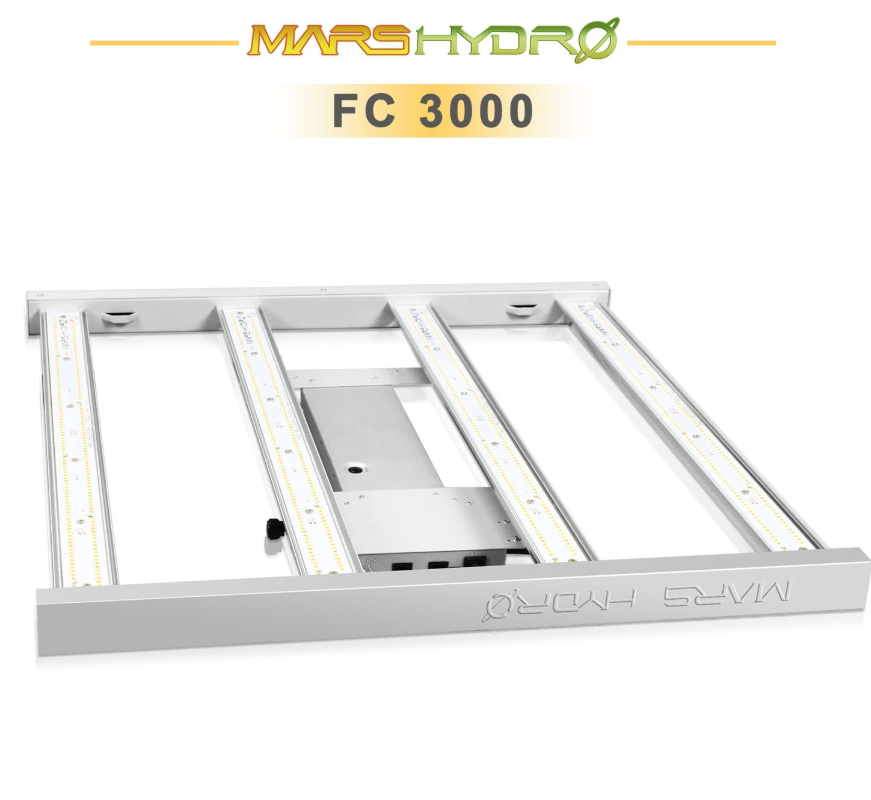
Features:
The Mars Hydro LED Grow Light was designed with commercial growers in mind, but is a perfect fixture for indoor gardens or grows of any size. The FC 3000 utilizes 896 leds with Samsung Lm301b and Osram 660nm for high output and excellent heat control. This efficiency translates to lower costs for the end-user. The Mars Hydro FC 3000 LED grow light is designed to concentrate the lighting on each bar, increasing light penetration into the canopy so plants have the opportunity to absorb more light. The FC 3000’s design and high-quality components make it a durable full spectrum led grow light with an incredible lifespan. Setup is a breeze with its independent, removable power supply. The aluminum heatsink allows for better heat dissipation and eliminates noisy cooling fans so your grow area remains quiet and cool.
Spider Farmer SE3000 300W LED Grow Lights
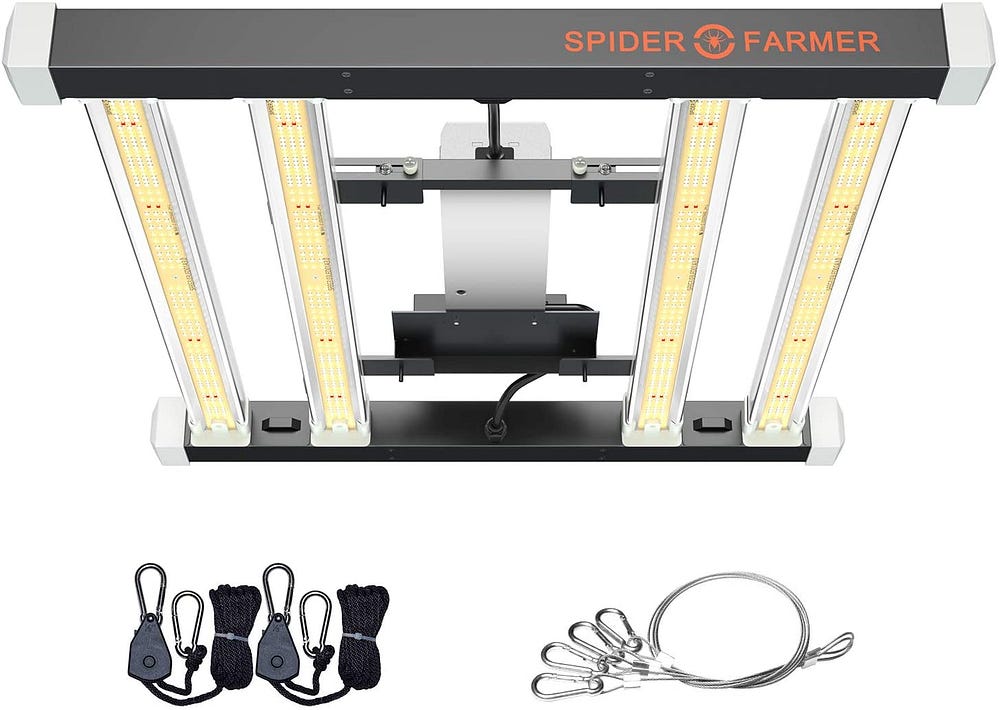
Features:
This Spider Farmer grow light has uniquely designed 6-LED bars and provides more even canopy coverage, especially to the outer edges of cultivation areas. With 2016pcs SAMSUNG LM301 diodes, SE5000 Led grow lights draw 480 watts with 1317.4umol/s, achieving an impressive PPE of 2.75 umol/J, coverage for 4'x4′ of high-yielding full-cycle growth. Full-spectrum (2800–3000K, 4800–5000k, 380–410nm, 650–665nm) is perfect for veg to bloom, to adapt to each phase of the plant cycle. The dimming knob is ideal for growers to adjust the light intensity according to different growing stages. Bar light design and aluminum material on the back contribute to better airflow and great heat dissipation. The daisy-chain function allows you to connect up to 15 SE7000 or SE5000 growing light — dimming multiple lights simultaneously.
Factors to Consider When Buying Commercial LED Grow Lights
Intensity of light
Plants need adequate light for healthy growth, and that is why the intensity of the LED grow lights matters. The intensity is not quantified by how bright the light is but more by the number of photons available. Different plants have different photon needs, and therefore it is important to confirm how much light is needed for those specific plants to thrive before making any decisions.
The number of light tomatoes needs to thrive will not be the same as, say, lettuce or basil because they are small plants. The larger the plant, the more photons will be needed to permit the plant’s healthy growth.
You should always check the PPF reading to determine the amount of light produced by the fixture. The term PPF refers to Photosynthetic Photon Flux measured in umol/s. The higher the PPF reading, the more photons your plants access to thrive.
If you want to cover an area of 4' x 4', an LED light with a PPF reading of 1500umol/s is adequate. Those who need more coverage will require larger LED lights with a higher PPF reading.
Area of coverage
If you want LED lights for commercial spaces, you need to understand the overall size of the area. This way, you can formulate a plan on how to make sure all the plants in the space have adequate light. You can choose to buy a large LED light covering the entire space or settle for several grow lights that are well spaced out.
Also, the number of plants in the space needs to be accounted for. You don’t want to overcrowd the area because the base of the plants will not be able to receive much light. Space your plants in such a way that proper light distribution and air ventilation are possible.
Ensure to check the manufacturer’s PAR map to understand the intensity of light in an area of a specific size. The PAR maps are a good way to estimate how much light each LED grow light has to offer according to the brand.
Spectrum
Another important feature to consider in grow LED lights is the spectrum. The spectrum generally means the different light wavelengths available. Plants at different stages of growth require different wavelengths for proper development. For example, red light is suitable for the flowering stage, while blue light works best for the veg stage.
In the marketplace, you find that LED grows lights either feature a broad or targeted spectrum. Targeted spectrums utilize diodes of specific wavelengths to equal photosynthetic peaks that facilitate chlorophyll absorption. Considered photosynthetically efficient, targeted spectrums may feature green, UVA, and Far Red.
Broad-spectrum models usually feature lower-powered diodes or white COBs paired with more diodes like UV to complete the spectrum. The white diodes are believed to give all of the vital wavelengths that plants need to thrive. The spectrum offers more green light rather than pink or purple that the targeted spectrum provides.
In short, consider what stage your plants are in, and source grows lights that will produce either quality plants or high yields.
Conclusion
Growing plants indoor require a lot of knowledge, hard work, and the right tool. The LED grow light is one of the most important tools of all. Hence, you must have the right knowledge about it before you go out and buy one.
Based on your requirements, you have to decide how much you can spend. The requirement and budget will help you narrow down the models that suit you. If you want more information on the model you decide to choose, always contact the manufacturer before buying.
Phlizon Newest 1000 LED Grow Light VS UNIT FARM UF1000 LED grow light
September 22, 2021
Light is essential for all forms of life on Earth. Sun, the pivotal star in our galaxy The Milky Way, is the source of required light, essential to keep life sustainable on our planet. Autotrophs, the organisms which can produce their food and energy, require ample amounts of light for healthily sustaining their lives. Plants fall in the category of autotrophs and are the most important living things on our planet. One way or another, plants form the backbone of food chains. To produce food, plants use light from the Sun to perform photosynthesis; a process whereby sunlight, water, and carbon dioxide are utilized to synthesize energy.
To ensure healthy plant growth and maximize yield, we need to ensure suitable conditions for the plants during their lifetime. One of these conditions is the provision of an ample amount of appropriate light, which the plants can utilize to assimilate food. Our specialty is to offer such lights to the growers, which may significantly assist them in obtaining a better crop; be it an indoor farm, a greenhouse, a kitchen garden, or a mini-garden inside the home.
Wavelengths of LED Grow Light
Blue light
The wavelength of blue light is 400nm to 500 nm. Blue light helps plants to grow. The absence of blue light leads to stunted growth. The leaves and branches turn out to be under-developed.
The grow lights from major companies are developed to ensure that particular light is provided for a certain stage of plant growth, such as blue for a particular phase and red for another growth phase.
For the cannabis plant, blue needs to be reduced at the flowering stage so that the buds do not grow long and lean as lean and long buds mean lower cannabinoids.
Red Light
Red light corresponds to wavelengths between 620 nm and 720nm. This range of wavelengths is suitable for the flowering phase. Having said that, only red is not sufficient, and there should be a blue wavelength also for vegetative growth at early phases.
UV Light
UV light or ultraviolet light corresponds to wavelengths below 400 nm. Wavelength in the range between 315 nm and 400 nm is UVA, while 280 nm to 315 nm is UVB and UVC corresponds to the range between 180 nm and 280 nm.
The advanced LED grow lighting includes certain UV ranges to enable cannabinoid growth. CBD and THC are triggered by plants as protection from UV light. Trichomes are the cannabinoids that we need, and the plant produces them as protection.
IR Light
IR or infrared light, as well as the near-infrared, correspond to wavelengths over 700 nm. This wavelength is responsible for the production of intense heat.
Blooming in plants is regulated by some photo-sensitive reactions due to the far-red and infrared wavelengths, aided by the photoreceptor, phytochrome. This process is different from photosynthesis, implying plants used different wavelengths for different purposes.
Phlizon Newest 1000 LED Grow Light

Features:
Phlizon grow light with 288pcs LM301B leds, higher light intensity, less light decay, better lumens, and PAR values than ordinary lamp beads. The intensity of light can be adjusted according to the needs of the plants. The leds are all LM301B leds chips, It contains 144pcs 3000K leds. No fans no noise and waterproof function. No additional fan zero noise. Otherwise, the plant grow light uses advanced waterproof power Actual power is 100watt with less. These LM301B leds run at a lower temperature than normal leds so there is no need for any heat sink. It also has higher light intensity, less light decay, better lumens, and PAR values than ordinary leds. and can bring higher energy conversion and longer life.
UNIT FARM UF1000 LED grow light
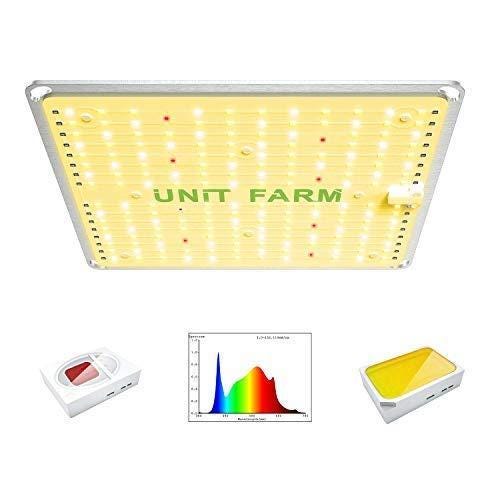
Features:
The UNIT FARM LED grow light has 184 LEDs that only consume 100 Watts. 2.7μmol/j high efficiency,Perfect for 2'x2' coverage at 18'’, 1.5'x1.5' Bloom coverage at 12”. Detached driver with extended power cord for protecting your plants from the heat, Better than the driver which soldered on top, Control your growing space easier. IP65 waterProof layer, Extend the performance time. The sunlike rich spectrum covers all growth stages. Composed of 100000 hours long lifespan Diodes from OSRAM. Offer you 2.5g/W yield max. UF Thin LED panel for hang up as you want. Can fit into more different places and even be used as side lighting. Can be used for hydroponics and soil, for greenhouse, vertical farm, grow tent. Make your plants much more pretty.
Guide to Choose 100w LED Grow Light
When shopping for great value, you need to consider some important aspects. Now, let’s take a look at the features below:
Type of led light
When you are finding great value in a flor light, it’s great to get a true full spectrum. In fact, we can know it offers full-spectrum only when we try it.
The wavelength you choose should stimulate photosynthesis. At the same time, the light should help your plant thrive and grow as well.
It’s best to choose the light wavelengths in the blue and red spectrum. They can be able to convert light, water, as well as energy into successful growth. Both of them actually make up the absorption waves of the spectrum.
We recommend you avoid choosing anything with a lot of white light. Actually, white light is known as a blend of yellow and green light that is beneficial to your plant. However, these lights can’t contribute to photosynthesis.
Energy Use
It’s essential to determine the amount of energy your plants are using. It’s important for both your utility bill and their immediate environment.
LEDs are famous for operating with virtually no heat. However, the heat of the light will be based on energy efficiency.
If it’s hard to look for an energy-efficient model in your wallet, you can choose an option with cooling fans.
Life Span
The fact is that all LED lights can die all at once. If the system doesn’t come with some technical failure with its power supply, you can easily see they slowly die out. You should look for a system with a lifespan of around 50,000 hours of use. It means that they can equate to about 10 years.
Conclusion
It might be hard for you to understand the technicalities behind the LED grow lights at first — but once you are able to work through them it will be a charm to be able to grow your home-based produce! This product does take a little learning to do but it goes a long way in helping you get organic farm-fresh fruits and vegetables with the highest nutritional value possible.
Overall, LED is an effective lighting solution to replace natural light. The more familiar you get with the technique — the better your indoor plants will look.
Monios-L T5 LED Grow Light VS EnviroGro T5 2FT 2 Tube Fixture w/bulbs
September 17, 2021
If you’re starting a growing project, it can be overwhelming when you consider how much money it’s going to cost you to start.
There really are a lot of things to consider. One of the most important factors to consider is choosing the best t5 grow lights.
And taking a look at the best t5 grow lights can give you an idea of what is coming your way.
Of course, that is not all.
You have to construct the room, figure out your heating and cooling systems, decide on hydroponics or traditional growing, and buy all your nutrients and equipment.
Grow lights are merely one aspect of your grow project, but they’re one of the most important.
The grow light you select is what will ultimately set the foundation for what kind of grow system you should establish.
Since your choice of light varies things quite a bit, let’s take a look at the complexities of the T5 fluorescent grow light system and how it compares against other popular grow light systems on the market.
The Pros and Cons of a T5 Grow Light
The Pros
T5 grow lights are extremely helpful with growing plants indoors. Besides being ideal to use indoors, they also have many other benefits. One is that they are much less expensive compared to other grow light options. This makes T5 grow lights good for beginners to use or for those who don’t want to invest in an expensive light system.
These grow lights are also much cooler compared to other grow lights due to them being energy-efficient. You won’t have to worry about them overheating or burning your plants. Also, due to their energy efficiency, they help to save money on your electric bill.
The Cons
While T5 grow lights have many benefits you should be aware of some things about them. One is that you need to make sure your T5 grow light has a red light. This red light will help with the flowering stages of your plants. Some of the T5 grow light models don’t have this color light so it’s important that you check to see if your model does. Otherwise, your plants might not bloom well.
These grow lights also have a shorter life compared to other light options. T5 grow lights only run for about 20,000 hours. This might seem like a very long time, but when it comes to growing plants it isn’t. You’ll have to be aware that you might end up having to invest a little in T5 grow lights. However, as mentioned above, they are affordable options.
The other downside about T5 grow lights is that you need to have a ballast with one of these lights. While most T5 grow lights have a ballast built into them, not all of them do. A ballast will help to prevent the lights from overheating which could damage your plants. If you find that your grow light doesn’t have one of these built into it, you’ll have to invest in a separate ballast yourself.
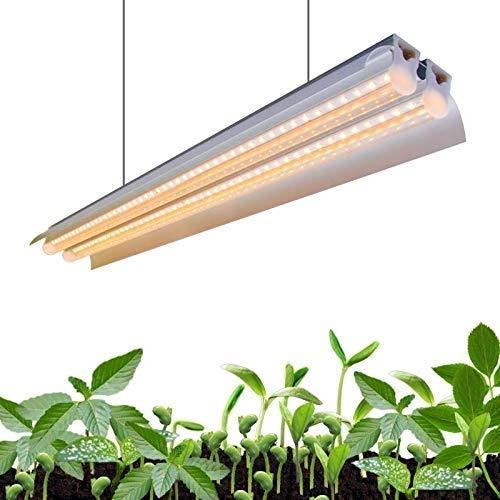
Features:
Monios-L 2ft led grow light with a full spectrum between 380–800nm, is the professional sunlight replacement for indoor plants. The 30W ultra-bright leds provide high PPFD ( photosynthetic photon flux density ), perfect for seedling, vegetative, and flowering cycles. 2900K color temperature makes the light appear warm white, which is comfortable for your eyes. This grow light are suitable for planting or displaying plants in any indoor application. Equipped with High-quality LED chips and aluminum housing, the light efficiency is increased by 25%, which can perfectly meet the light needs of the great majority of plants.
Power Source AC
Material Aluminum
Style Garden
Mounting Type Hanging
Special Feature Dual Switches, Full Spectrum, Linkable, Plug and Play
EnviroGro T5 2FT 2 Tube Fixture w/bulbs
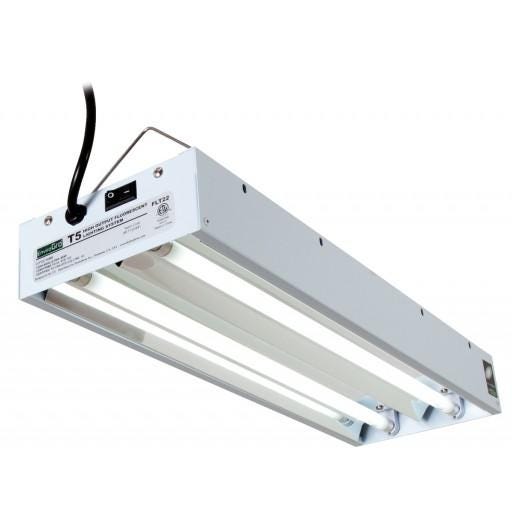
Features:
Hydrofarm’s newest T5 System delivers performance, flexibility, and high lumen output in any growing environment. These systems allow you to choose multiple hanging configurations to meet your garden’s design. They combine German specular aluminum with energy-efficient/high-output T5 bulbs and put out double the light energy of normal fluorescent systems.
Lumen output rated up to 4000
Powder-coated, pre-galvanized steel housing
UL Listed ballast with 5-year warranty
Low profile
It Hangs 3 ways — overhead, vertical or horizontal
10’ grounded power cord
Includes 4 fluorescent 6400K, T5 tubes
UL Listed
How Many Lamps Should Your T5 Grow Light System Have?
Another essential aspect to look for when buying the best T5 grow light is the amount of lamps. T5’s generally come with 2, 4, or 8 bulbs depending on the size of your grow space. This is a critical aspect to know before you buy.
Whether you grow in a room or a grow tent, the number of cannabis plants will be the determining factor in this category. In my experience, as long as your plants receive a full 360° coverage, they’ll happily produce ample buds.
To determine how many bulbs you’ll need in your T5 grow system is to know how many plants will be in your grow room.
Other important aspects of assessing beforehand are: how big or small will your plants be during flowering? Will you utilize the Screen of Green technique (ScrOG) or the Sea of Green method (SOG)?
I’ve seen countless grow operations where a single cannabis bush required a full 8-lamp T5 grow system all to itself. On the other hand, you could potentially fit 9 small cannabis clones under the same 8-lamp T5 system.
How Efficient Are T5 Grow Lights?
Since T5 grow systems are optimized for flexibility, they can be used in all phases of a cannabis plant’s life cycle.
If you’re one of the few that enjoys growing cannabis by seed, then you know that young sprouts need enough light to avoid stretching.
T5’s allow for you to dim the bulbs and reduce the power output by 50–75%. This amount of light is perfect for keeping sprouts short and without inducing any additional stress.
During the vegetative phase, you can increase your power output to make sure your cannabis plants are receiving the light they crave to fuel their growth.
T5’s are perfect for keeping close enough to the canopy without the worry of inducing heat stress. In stark contrast, HPS and MH need to be at least 6”-12” or more above the canopy to avoid heat stress.
Your T5 can be placed 1”-6” above the canopy, which also enables your plant to grow short nodes. The reason for having little space between nodes is that your plant will stretch less during flowering and bud sites will remain compact.
During the flowering stage, you can boost your power output to 100%. This allows your buds to grow without hindrance, all the while keeping your T5 4”-6” above the canopy.
All of these aspects enhance the quantity of your eventual harvest and keep your grow room efficient. T5’s give us the ability to control so many important factors in growing marijuana.
Conclusion
Growing plants can be easy thanks to T5 grow lights. These lights are specially designed to help with all stages of your plant’s growth. While these lights are energy-efficient and affordable you do need to keep a close eye on certain aspects of them, like making sure they have a ballast.
3 Best Herb Ginder Reviews (Updated Sept 2021)
September 15, 2021
A herb grinder is an essential tool for the modern toker to grind up their flowers for either rolling, packing a bong, loading a hand pipe, or anything in between. Grinders often come in multiple parts and contain several chambers, and work by crushing and cutting up your herb into smaller pieces.
Choosing a good grinder will spare you the painstaking and sticky process of picking apart herbs by hand.
The most common style of grinder is the multi-piece grinder, which uses several pieces that connect to create an area for grinding and storing. Many smokers find these grinders to be the most useful for the extra storing space, which can vary depending on size and diameter
What do customers often consider when choosing a weed grinder?
Material: Grinders are made from several different types of materials, from acrylic to aluminum, or anodized metals. Most people prefer a metal grinder for its durability and feel.
Compartments: Many grinders come in several tiers of layers. The multi-piece grinder often contains a compartment for kief and pollen, while the two-piece grinder simply just grinders your herb.
Size: Portability and the amount of herb you can grind depend on size. Large grinders can store and grind more herb at a time but will be heavier and bulkier to carry around.
Why Use A Weed Grinder?
Using sharp teeth and a little hand power, or the press of a button if you’re working with one of the fancier electric types, a weed grinder rips your herb apart so that you don’t have to spare your fingernails or sacrifice the only pair of scissors you have in the house. As a result, you get perfectly smokeable ground bud without a sweat.
When you’re operating without a grinder, you can’t get your herb as fine as possible for optimal burning, especially if it’s that sticky-icky. Not to mention, you can’t get kief, the resinous trichomes that sparkle all over your bud and are mighty potent. Not easily, at least.
You could spend minutes cutting, or worse, picking your bud. Or, you could use a grinder and break down your stash in seconds and get kief, which you can sprinkle over your flower to enhance it. Talk about the icing on the cake.
Grinders also ensure an even burn. If you pack a bowl with chunky bud, then you can’t get as full of a bowl pack, and you’re essentially wasting it because it can’t heat it as thoroughly. Moreover, it’s harder to stir, and more often than not, there is still some green left, which you won’t realize until you go to dump out the “ashes.”
ECO Farm Medicinal Plants Grinder

Features:
The ECO Farm grinder is made out of medical grade stainless steel, and gives you peak customization when purchasing: you can choose from a three-piece or a four-piece grinder, and you can choose between a coarse grind or a hybrid grind. The deep cutting area allows you to pack the grinder with a larger amount of product, and a stainless steel ball agitator gets all of the kief off of the grinder. Speaking of kief, the grinder has a kief catcher and additional scraper.
Kcanabears Mini electric vanilla grinder

Features:
Although the price may be slightly higher than our average here, so is the quality. One of the first features for flower lovers will notice the smooth grinding. As I mentioned before, this is not obvious. Most grinders expect you to use a lot of force, which often leads to damage to the herbal grinder. The presence of healthy herbs reduces all impurities, making it stronger than ever. The product also contains a removable stainless steel screen. As we have seen in other grinders, this makes cleaning easier.
TSS Electric tobacco shredder-cutter-converter

Features:
This electric tobacco shredder is perfect for shredding all your tobacco, even any legal smoking herbs you may carry with you. This high-power shredder can process up to 50 grams of vanilla or tobacco, and you can even mix them together at the same time to create your own custom blend. Chopped vanilla and tobacco make them easier and more consistent to smoke, and will make a difference in the hand-rolled cigarettes you make.
What to Look for in a Weed Grinder
1: More Chambers, More Options
A standard two-chamber grinder will get the job done, but your options become endless once you upgrade to one that has a kief catcher and additional chambers. A friend described adding “middle weed” — weed that’s not kief but more fine than what typically get used — to a Volcano to get a more flavorful high. Mess around with different combinations of consistencies to get different highs.
2: Look for the Teeth
The teeth shape, and the number of teeth, affect how the weed is broken up. However, more teeth doesn’t necessarily mean better (you don’t want weed that’s too fine right off the bat), and not enough teeth equals chunky weed and more time grinding.
3: Material Matters
There are three kinds of metals typically used to make grinders: zinc, aluminum and stainless steel. There are plastic grinders on the market, but you might encounter a broken tooth if you’re grinding tough weed. Additionally, cheaper grinders might be coated with paint or a finish, which could chip off and get into your weed. You definitely don’t want to inhale that!
4 Grip is Important
The better grip a grinder has, the easier it’s going to be to use. And, an easier grip means you have to use less torque (the measure of force that causes an object to rotate around an axis) to grind the weed. That’s important if you’re a user who experiences a lot of hand pain.
5 Don’t be Afraid to Splurge
Grinders get a lot of use. A cheaper grinder might not last you as long as something made of high-quality metal. Paying more gives you the peace of mind that a tooth won’t break, the product won’t flake, and that nothing funky from the grinder is getting into your weed.
Conclusion
If you’re looking for the best cheapest weed grinder, look no further than the ECO Farm Grinder.
There are a LOT of cannabis grinders to choose from out there, but these are the three that people use daily.
Let me know in the comments what kind of setup you have and what grinder produces the best results for you so other people can see what works and what doesn’t.
Maxibright Daylight 480w PRO LED Grow Light VS SideKing SK5000 LED Grow Light
September 03, 2021
When it comes to growing healthy plants indoors, light is an important factor to consider. There are lots of indoor plants that are easy to care for but what they all have in common is light as growing indoor plants can be a bit challenging.
While some houses are going to have lots of windows for all your houseplants to sunbathe, some are not made for growing plants as they might be dark and this is where led light comes in.
It is ideal to have your plants positioned in front of the window so they can get natural sunlight but this might often be impossible. While some plants can easily adapt to low-light situations, some plants do not.
When you are working with low lightroom, you might want to carefully select the plants to grow. But if you are looking to grow plants that require sufficient light to bloom then you need the best-led grow light.
Type of LED
The three most common forms of LED grow lights are: panel, bar and bulb. Let’s take a look at the advantages and disadvantages of each method.
LED light board
When it comes to indoor planting, panels are probably the most common. One of the reasons for their popularity is that many have radiators-mechanisms designed to remove excess heat from lamps. Now is a good time to get to know the radiator quickly.
If you think that LEDs do not generate heat, you can’t be completely wrong. The LED feels cool to the touch. But inside the mechanism itself, there is still a lot of heat.
The other advantage of LED light panels is that they provide a full spectrum of light to adapt to the different growth stages of plants and to simulate natural light. They do this by providing a balanced spectrum of red, blue, and green light.
They are ready to be “plug and play” with any standard electrical outlet, and are designed to run for very, very long periods of time. What we are talking about here is a bright life for decades.
The disadvantage of full-size LED light panels is cost. By far, panels are the most expensive way to provide high-quality LED lights for your indoor plants.
LED strip
The light bar is like you take a row of diodes from the light board and use it as a standalone tool. They are convenient because you can easily increase the light footprint without having to invest in new LED light panels. Another advantage of a single row of light bars is that you can change the spectrum provided to plants. LED strips should be considered as supplementary light for any main light source you use.
Due to their complementary nature, one disadvantage is that unless you invest in multiple light bars, they are difficult to use as your only light source. They usually have only one spectrum and cannot switch to a different spectrum.
LED bulb
The bulb is the single source of the LED light. Most even have the same traditional shape as CLF and incandescent bulbs. LED bulbs cannot be inserted like panels or light bars. But they fit any standard lamp holder. The advantage of LED bulbs is that if you have more than one, they can be used to provide different spectra. You can customize the type and placement of the light provided for the plants.
An obvious disadvantage of LED bulbs is that unless you illuminate a single plant, you will need multiple lamps and bulbs to provide the full spectrum of your plants. If you have equipped your plants with a small number of fixtures and bulbs, it may be time to upgrade to a single light board or a series of light bars.
Maxibright Daylight 480w PRO LED Grow Light
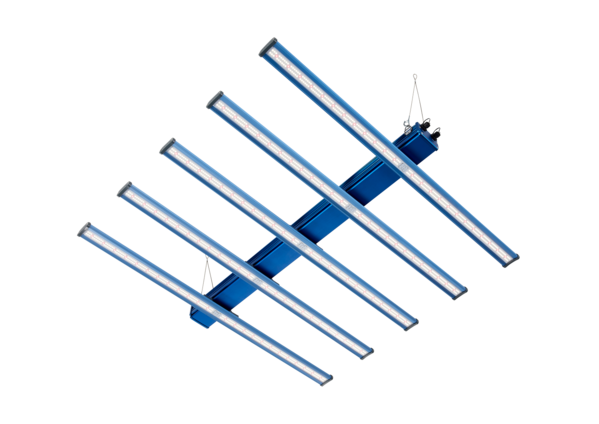
Features:
The new full spectrum Maxibright LED grow lights from Maxibright are high output units that push the envelope for plug-and-play LED grow lights. A superior fixture efficiency works to improve final yields. The ability to dim the fixture from 25% up to 100% power, means you can use it from the early stages of growth right through to flowering. The Maxibright Daylight Pro LED Grow Light has been designed so that it’s easier to transport than similar alternatives. For this reason, you’ll need to assemble it when you receive it, which can be done comfortably in 5–10 minutes. The benefits on offer from the Daylight LED grow lights are convincing even the most hardcore HPS growers that switching is more than worth the investment. A fanless, solid-state design provides silent operation and eliminates the risk of mechanical failure.
SideKing SK5000 LED Grow Light

Features:
SK5000 led plant light boasts high efficiency rating of PPF per Joule reach up to 2.8μmol/J, providing powerful light output and enhancing canopy penetration to resulting in higher yielding footprint, Veg coverage is 5 x 5 ft, Flowering coverage is 4 x 4 ft. SideKing commercial grow light has a 5-level dimming knob on its driver, it can also dimming precisely by an external dimming knob, which makes it adaptable to different growing periods for your plant. The daisy-chain function allows you to connect up to 15 SK5000 LED plant lamps through the RJ11 port. SK5000 foldable grow lights use newest aluminum heat-sink design, No fans ZERO noise, reducing the probability of problems due to overheating, allowing your plants receive more energy.
The best LED plant growing lamps have excellent chromatography
The color of LED lights is important. Different manufacturers have created their own red and blue blends, which are the colors that contribute the most to growing healthy plants through the vegetable and flowering stages. Red light is perfect for photosynthesis.
Do LEDS have both ultraviolet and infrared light?
Ultraviolet and infrared rays are important for growing plants with LEDS. The uv function sterilizes growth and kills bacteria that can affect a plant’s ability to produce healthy flowers. IR function promotes cell division, thereby improving vegetation and flowering growth.
When choosing LED plant growth lights, intensity is important
Light intensity is an important factor to consider when growing through LEDS. Depending on the size of your footprint, you may consider adding smaller LED growth lights to your headlights. Also, create an environment where you can keep LED plant lights on top of plants as they grow over time.
Temperature control benefits of LED plant growth lamps
Temperature can play an important role in ensuring that your plant lights are well ventilated, whether you’re growing in a hydroponic tent kit or a large greenhouse environment. LED lights can still generate enough heat, you need to ensure heat dissipation by using fans or ventilation. LED plant growth lights also benefit from longer service life when used in conjunction with cooling systems.
LED plant growth lights facilitate efficient growth
The daily growth plan depends on the growth stage of your plant; Germination, nutrition and flowering. The taller and longer your plants grow, the fewer hours your LED lighting needs to be supplied; Usually from 17 to 14 to 11 hours.
LED plant growth lights require safety goggles or glasses
Safety is also a big concern, so make sure you wear protective glasses when turning on the lights.
Conclusion
Choosing the best LED grow lights for indoor plants is known as confusing, but with such a growing guide, you can easily solve these problems. Price, spectrum and output are also factors you should consider.
LED grow lights are quickly becoming a trend for indoor plants because of the overwhelming plant yields that can benefit from it. Whether you are a farmer or a seasonal grower. LED grow lights are what your indoor plants need.
ECO Farm FLD 320W Full Spectrum Dimmable LED Grow Lights BarVS Rapid LED FM320 LED Grow Light
September 02, 2021
Being stuck at home — even during the winter months — is a great opportunity to grow an indoor garden. It’s a relatively cheap hobby, even factoring in the number of plants that might not make it, and can significantly improve the air quality in your house too.
Along with water, plant food, and the optional operatic singing (there’s still debate as to why, or if this works, but it’s worth a shot), an indoor LED grow light can be enormously helpful to kick growth into high gear. The various colors of the bulbs simulate sunlight, which plants need to capture and process, and eventually helps them grow up green and healthy just as if they’ve been outside.
Why Choose LED Grow Lights?
LED grow lights are a great solution for today’s indoor plant grower. When buying LED grow lights, you need to consider their durability. The construction should be of high quality. If not, then you’d be wasting your hard-earned money. LED grow lights provide the spectrum of light your plants need. If your plant doesn’t get enough light it will not grow strong. Then the productivity of the plant will decrease as well. So, if you don’t get enough fruits and flowers from your indoor garden, you can use some cheap led grow lights. Also, if you need to save them from snow or cold by providing enough daylight for your plants.
What’s the difference between PAR, PFD, and PPFD?
As you’re shopping for your LED system, it’s easy to get overwhelmed by the barrage of technical terms on each product. Although you don’t have to know every technical detail, you should be familiar with a few essential terms. Don’t worry if you slept through science class; we’ll try to make this lesson as simple as possible.
Before we get into PAR and PPFD, keep in mind plants are far more sensitive to lightwaves than humans are. So, when measuring light intensity in horticulture, we can’t rely on measurements that only account for what humans perceive.
To understand the amount of light that can photosynthesize, we first have to examine PAR (aka Photosynthetic Active Radiation). The PAR, expressed as W/m2 tells us how much light your unit can produce for photosynthesis. PAR does not, however, tell you anything about the light’s strength.
For more detailed info, we need to consider the Photosyhtnetic Photon Flux (PPF) and the Photosynthetic Photon Flux Density (PPFD). Although these terms are sometimes used interchangeably, the PPF should only express the PAR per second (μmol/s). The PPFD, on the other hand, takes the area into account (µmol/m²s).
Technically, the PPFD is telling you how many photons are hitting one square meter of space every second. Since PPFD takes area into account, you’ll notice different measurements at different heights.
Although plant cultivators have different ideas for the ideal PPFD, most people subscribe to the following ranges:
200–400 PPFD for early stages of development
400–600 PPFD for the vegetative stage
600–900 PPFD for the flowering stage
ECO Farm FLD 320W Full Spectrum Dimmable LED Grow Lights Bar
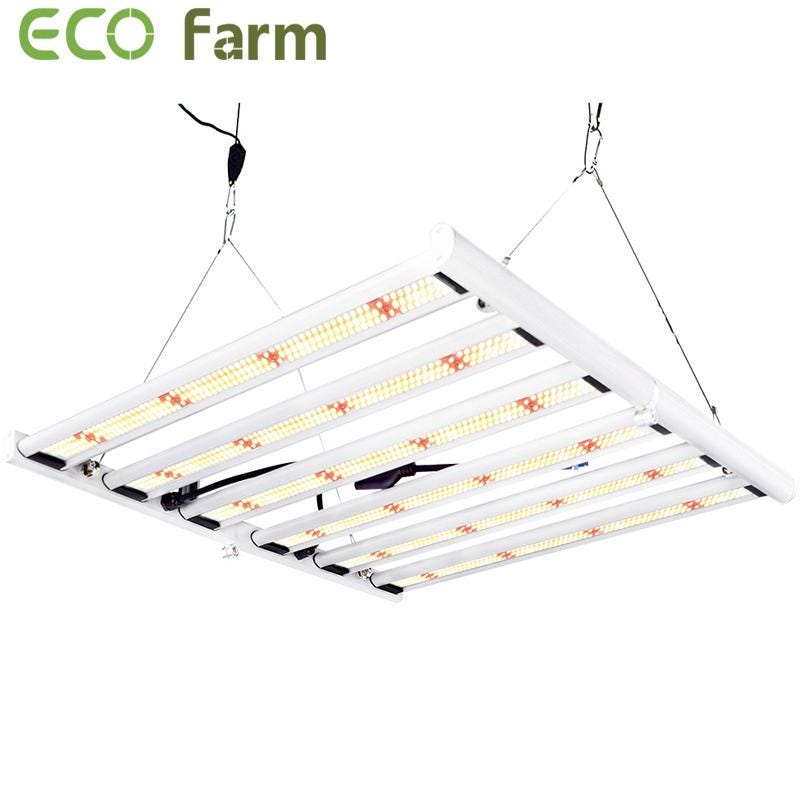
Features:
This ECO Farm LED grow light with upgraded SMD 3030 chip 6 passive-cooled led bars, higher light intensity, less light decay, better lumens, and PAR values than ordinary LED chips. FLD 320W uses 1200 LED chips that consume only 320W, perfect coverage for 3x3ft, helps you achieve maximum quality and quantity. The intensity of light can be adjusted according to the needs of plants. It can be freely adjusted lighting intensity as plants need growth at different stages with dimming options ranging from 0 to 10 levels. SMD leds spectrum is white 3000K leds, white 5000K leds, 660nm red led, and 740nm IR leds. Master light is easily controlled for commercial & home horticulture.
Model: FLD320
Actual Power: 320W
HID Replacement: 1500W HPSMH
LED Quantities: 1200pcs LEDS
Input: AC100–277v,50–60Hz
Full Spectrum: 3000k+5000k+660nm+730nm
Lifespan: 2150,000 hours
Weight: 14.3Ibs/6.5kg
Rapid LED FM320 LED Grow Light
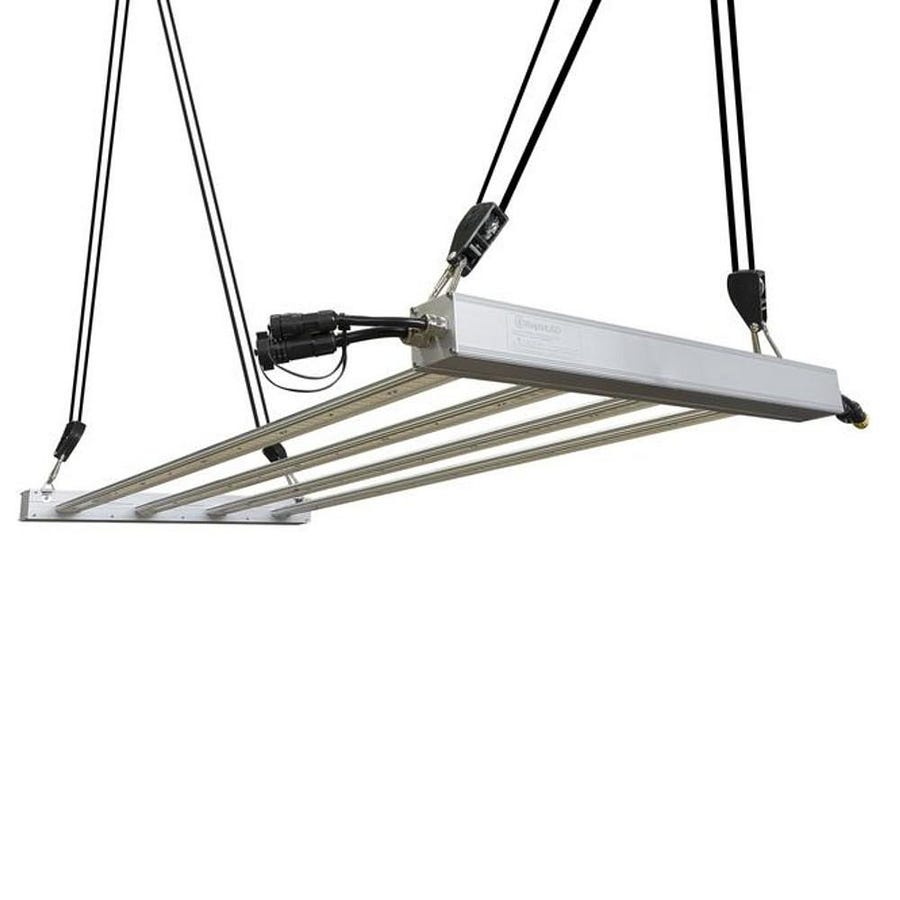
Features:
The FM320 is Rapid LED’s easiest-to-use fixture perfect for those that want a reliable, affordable lighting option ready to go out of the box. With system-level efficiency between 2.5–2.7 umol/J and a choice of either 3200K or 4000K color temperature this fixture is great for either full-cycle/veg/rooting (4000K) or flowering (3200K). This LED grow light has lower power consumption and a fanless design. It is a slim profile for space-constrained applications such as vertical farming. Units can be connected in series for simple power and dimming wiring Finally, it can be dimmable via any 0–10V/1–10V dimming signal.
Wattage Draw : ~300W From LEDs (320W From Wall)
Coverage Area : 4' x 4' Veg / 3' x 3' Flower
Dimensions : ~47" x ~21" x 2"
Dimmable : Yes (Manual Dimming Down to 40% Included)
Veg Footprint 4' x 4'
Flower Footprint 3' x 3'
Spectrum: Full
Light Output : HID/HPS Equivalent 500 watts
Dimensions: 47" x ~21" x 2"
Manufacturer’s Warranty 3 Years
Our Comprehensive Buying Guide
So, you’ve decided to grow your own veggies and plants inside but you’re not sure how that works? Apart from fertilizers and water, you will also need to pick the best LED grow lights for indoor plants. And, since there are plenty of options available on the market, these aspects will help you pick the right product, according to your needs.
Consider the plants you’re growing
Keep in mind that not all plants require the same amount of heat and light to grow big and strong, meaning too powerful full spectrum LED grow lights could easily burn them. This is why it is extremely important to know your plants and their needs.
For example, heavy crops like tomatoes will need more light to maximize growth, as opposed to most flowers. Lights should also be picked based on the growing stages you are focusing on, meaning certain types of lights are used for vegetative cycles, while others are required for flowering or complete growing processes.
The size of your growing space
Space availability is another important factor that will help you determine which type of lighting goes best. Make sure to properly measure the total size of your garden and calculate the lighting area size of the lamps you will need.
As you can find later in this article, most growers recommend 32 watts of actual power per square foot of growing space, if you think about growing high-light plants like peppers and tomatoes. Low-light plants like herbs or lettuce will only require between 11 and 18 watts per square foot.
Full-spectrum LED lights
Although plants can grow under different types of light, efficient photosynthesis needs different wavelengths that can be easily provided by LED grow lights full spectrum.
To grow efficiently, many plants require light in the blue and red spectrum, as well as ultraviolet and infrared, depending on their growth stage. Most cheap LED grow lights won’t be able to cater to the specific needs of the plants, which can result in smaller crops. So, if you want your plants to properly grow with LED lights, the full spectrum ones represent the perfect solution.
Quality of the materials
Growing your own garden implies having high-quality lighting at all times, and this is why the durability of the materials used to make the LED lights is crucial. When properly built, LED lamps can last for around 10 years.
All lights should have the same intensity otherwise they won’t lead to a uniform growth of your plants. If some of the lights flicker or burn, your crops will become under-developed.
If you want to avoid these problems, it would be best to test the lights before purchasing them. Similarly, buying from reputed brands that abide by the industry standards in the United States can guarantee you high-quality products.
Low heat output
This is one of the most important features you need to consider when picking your LED grow lights for indoor plants because it contributes to plant protection and durability.
Depending on the type of plant you are growing, the lights will be positioned some inches above, and having low heat output guarantees they won’t get burnt.
Conclusion
Choosing the LED grow light that’s best for you really depends on what you need it for. A small bulb with low-wattage LEDs can be plenty for your little herb garden, but if you have a huge crop of plants, you might need something more powerful. The most flexible of our top picks is the ECO Farm 320W LED Plant Grow Light, which offers a good balance of power and light to help indoor plants grow. It is a good grow light to get smaller plants started. You can’t beat its warranty, which helps protect your purchase in case of any defects. Plus, it’s an affordable option if you need to grow plants even in the winter.
Enlite Hera 660W Full-cycle Grow Light VS BIOS ICARUS® Ti2 Grow Light
September 01, 2021
If you don’t have an outdoor space, or you live in a cool climate with a short growing season, indoor gardening is the way to go. Plants need the right kind of lighting to thrive, however, so you’ll probably need to invest in some LED grow lights.
The question is, which ones? You can find hundreds of LED grow lights for sale, and not all are created equal.
Read our full guide to LED lights, and discover how to find the perfect lights to fit your requirements.
How to Hang a Grow Light
Learning the art of hanging LED light correctly is a tremendous step towards creating a quality environment for your horticulture plants. Before you hand them, consider a position that ensures that there is light uniformity. After calculating the LED light intensity, determine at what height to hang. Finally, following the instruction ensure the installation is correct and effective.
How Close Should a Grow Light be to Plants?
It would be great if the grow light’s position is expendable such that as the plants grow towards the source, you can vary the distance. Fluorescent and LED grow light has lower heat signatures and can be pleased around 12 to 6 inches from the plants. Led lights are usually power-saving y so they cannot cause a burn to the plants. That’s why their distance is ok to be closer to the plants.
However, incandescent bulbs use heat to light; hence should always be far from the plants, if possible, up to 24 inches. To minimize such confusion consulting the manufacturer is a very advisable move.
Enlite Hera 660W Full-cycle Grow Light

Features:
The Enlite LED grow light is designed as a primary top-light for indoor cultivation or as a supplemental top-light solution in greenhouses for higher crop yields and better crop quality. The Hera 660 watt fixture is only 3.2” wide and creates a very small shadow effect in the greenhouse, yet it has 120° wide beam optics to provide excellent light distribution in a large area. Enlite Full Spectrum differs from other fixtures because they have added 10% more infrared which results in strong stem growth, proper node placement and larger flower yields. This grow light is equipped with Samsung LM301H diodes with an efficacy of 2.45 µmol/J and a light output of 1617 µmol/s. With a patented-design heat dissipation structure, Enlite Hera grow lights allow lower working temperatures
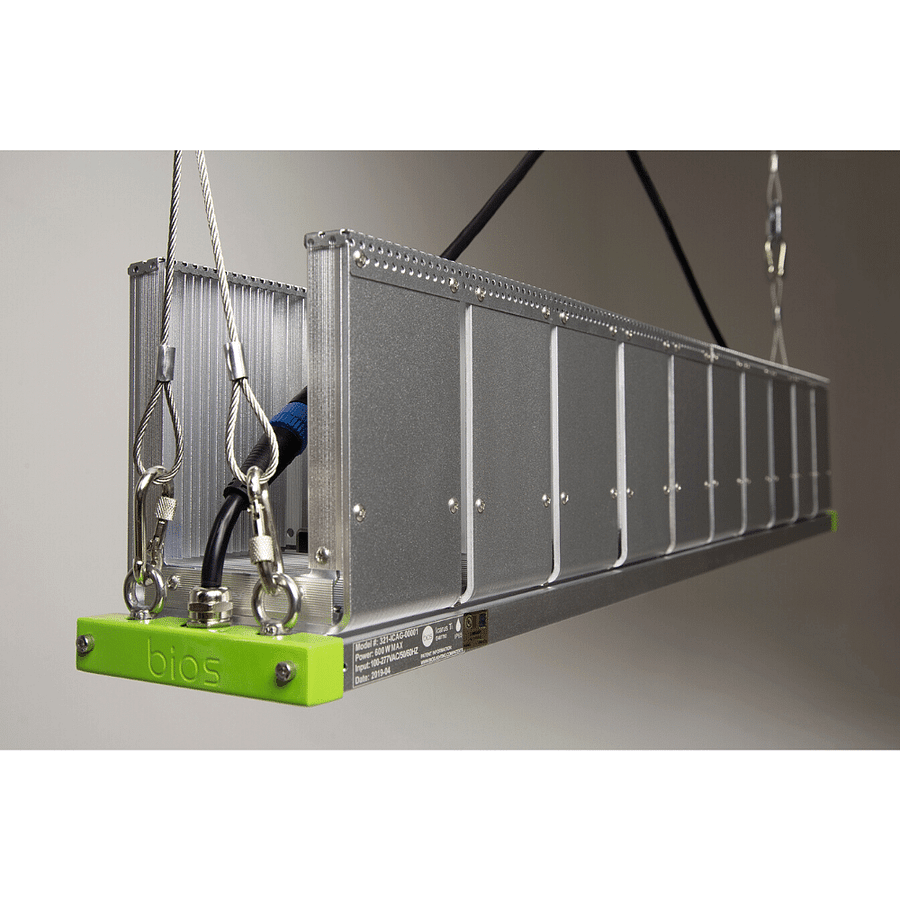
Features:
The BIOS LED grow lights offer maximum light output in a minimal footprint and durable form factor to boost crop production for greenhouse or indoor top light growing environments. The BIOS biology first approach allows for a scientifically engineered spectrum that maximizes photosynthesis and growth. The grow light also features a heat pipe design that pulls the heat away from the LEDs to keep the fixture cool leading to a longer life span. The grow light is spectrally optimized to improve overall plant health and increase yield while providing a high output, energy efficient solution for all your lighting.And optimized broad spectrum, dimmable light for all phases of plant growth and production.
Guidance To Buy Best Led Light For Your Grow Tent
A buyer guide is simply a collection of suggestions that gives a customer an idea of what to look for in the market situation. Therefore, this section draws apparent factors that a customer needs to know when looking for the best-led light for a grow tent.
Light Spectrum
The plants you grow and the spectrum need at various sages should dictate the grow light’s type to buy. Generally, the combination of good quality blue and red spectra is sufficient for most greenery plants. If you plant vegetables, ensure your light has yellow, orange, and green ranges. Therefore choosing multi-spectral LEDs are the best or choose full light spectrum grower lights with proper VEG/BLOOM settings. Light spectra are crucial to plants, just like a balanced diet is to a human being.
Intensity of Light
Both location and luminaire of light determine light intensity. The plant types and habitat requirements define the light you should install in your tent. The closer the light source is to the plants, the more intensity. Therefore you should buy a system that will generate sufficient light intensity according to your plant’s needs for light. Practically, the plant top should be at least 10cm from the light board; otherwise, the light may burn the plant. So when shopping for the best led grow light for a grow tent, make sure it will give your plants sufficient allowance to grow.
Ease of Installation
Do not go for grow lights that need masters in rocket science to install as that will attract more cost from the handyman. Just look for easy-to-install lights that you can even install yourself using the manufacturer’s guidelines.
Heat Generated
Depending on the type of plants you want to grow, some require both light and heat. The good news is that some available grower light offers light spectra and a certain level of heat. If you plan to grow such plants in your grow tent, it would be wise to invest in LED bulbs that offer light and some degree of heat.
Lifespan and Energy Saving Ability
Generally, LED light bulbs or boards are relatively expensive than other standard bulbs and can last up to 5 times longer. The good thing is that they are more long-lasting and can offer quality service in the long run. LED light bulbs can withstand on and off switching without blowing, which is why other bulbs do not last as their filaments burn easily. These lights lamps use electric current to light and hence are the most energy-efficient you can ever have. Led bulbs are, therefore, better, unlike incandescent bulbs, which use heat to light.
Price
Although a high price is mostly directly proportional to the product’s quality, it defeats logic when you cannot afford it; when buying LED grow lights to support your plants’ growth, make sure you obtain the ideal LED light in terms of quality your budget.
Conclusion
There was a time when very few growers would consider, let alone recommend, LED lights for growing cannabis. But as technology advances, manufacturers have been able to refine the design of these light-emitting diodes to provide a high-quality light source perfect for your growth.
Modern LEDs have come a long way since their initial development and use in practical technology. The advantages of LEDs include lower energy consumption than traditional HID and CMH lamps. Additional improvements include improved durability, small size, and faster switching of the diodes. In fact, LED technology has improved so much that can even be used as in-home lighting.
What Are The Best Grinders For Your Plants?
August 31, 2021
A good grinder is a must for every plant aficionado. Rolling a perfect joint is impossible without breaking up chunks of the plant into smaller pieces. Traditionally, people use their fingers to crush or scissors to cut. Regular plant users though favor the use of this handy kitchen utility.
What material is most of the grinders made of?

When looking for a grinder for the plant, you will come across a variety of products in the market. There are grinders made of different materials that are available in the market. The most commonly used materials include wood, acrylics, and even metal.
The more high-end grinders are usually made of stainless steel, zinc and aluminum alloys, and even titanium. Grinders made of wood are also available in the market, but these grinders are mostly single chamber grinders.
Some other features that are common amongst almost all the grinders include a magnetic lid to securely close the grinder and grips that make holding and using the grinders easier.
Some grinders with attractive designs are also available in the market.
These grinders are specially made for patients suffering from severe medical conditions, so their moods can be boosted, and they can feel better.
How do I clean my grinder?
There are numerous ways to clean a grinder. It is essential to clean grinders to ensure hygiene and also because particles that are stuck in the grinder can lead to a blunt grinder. The best way to clean a grinder is to disassemble its parts and put them in a freezer.
It is essential to wait until all the pieces are adequately frozen. Once frozen, they can be tapped onto any paper towel, and the small particles stuck inside will fall out easily.
Grinders can also be cleaned with alcohol. For this method, dip any cotton cloth in some alcohol and use a cloth to wipe the different parts of the grinder. Be careful and clean the edges and crevices of the grinder properly. Any residue stuck in the grinder can be easily removed with the alcohol.
Sometimes alcohol cannot remove the particles altogether. In this case, use a toothpick or a brush to remove the softened particles from the grinder. Once done, rinse the grinder under some warm water, and it should be clean and ready to be used. Once done rinsing, ensure that the grinder is dried as moisture can cause the metallic parts of the grinder to get rusty.
How many plants can you put in a grinder at one time?
The most common mistake that people tend to make when grinding plants is to overpack and stuff the grinder with too much plant. It is recommended to fill up the grinder gradually. Add a few flowers of the plant and check to see if there is more room.
If there is more space, add a few more. Once the grinder is full, you can move ahead and start grinding the plants. The plants that are ground will begin passing through the holes of the grinder and move into the collection chamber.
If you notice that the grinder is now working exceptionally smoothly, it is an indication of the fact that the material placed inside the grinder before has been ground. More plants can be added to it now. So you can open the topmost chamber and add more plants before you continue grinding.
What Factors Should One Consider Before Buying A Grinder?
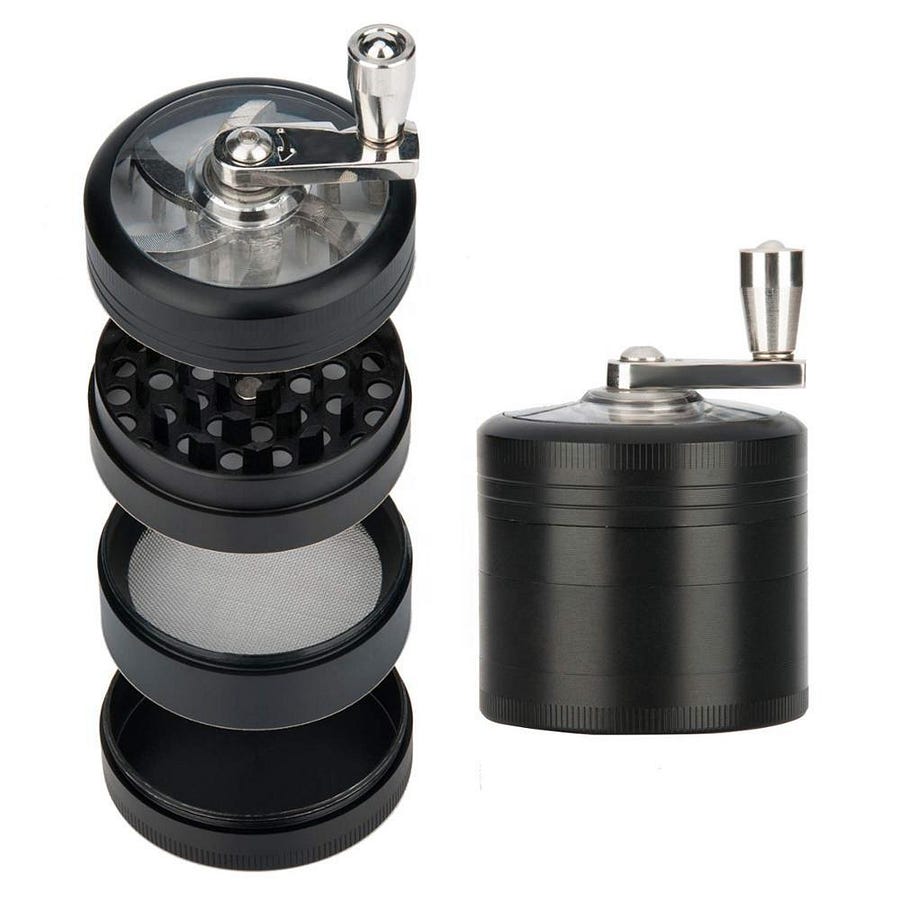
Grinders Benefits:
Grinding plants increases the surface area of the plant and thus makes it easy to heat up. The larger surface area causes the plant to heat uniformly. Which leads to potent vapors and a better experience when smoking the plant.
A grinder is also useful as it helps one take maximum advantage of the dry plants. When ground smoothly, even a smaller quantity of plants can have an amazing effect.
A grinder helps enjoy plants to the maximum without having to use too much product. Therefore it also helps save a lot of money. A significant factor is it decreases the time spent on the vaping sessions.
Kief is the most potent and robust component of a plant that can cause one to get high. Grinders are a great way to segregate this kief from plants so that it can be turned into hash. The kief is separated from the plant and remains in the grinder. This kief can then be collected and utilized as desired.
Categories Of Grinders:
Generally, grinders have either two, three, or four parts. Thus you can choose grinders between 2-Piece, 3-Piece, and 4-Piece Grinders.
2-Piece Grinders:
A 2-Piece Grinder comes with a single compartment for the plant. This compartment can be used for both storing as well as grinding the plant. It is cheaper as compared to the other category of grinders, but the downside is that it does not produce consistent and uniform particles of the plant. But it is perfect for people who are looking for an affordable grinder.
3-Piece Grinders:
The 3-Piece Grinders come with two separate compartments. Both the chambers are connected through holes pierced at the top of the bottom layer. The purpose of these holes is to ensure uniformity in the size of the particles. This partition also increases the surface area of the grinder.
The particles when using a 3-piece grinder are finer as compared to the particles of plant ground using a 2-Piece grinder. The ungrounded plant is stored in the second compartment and can be retrieved from there.
4-Piece Grinder:
A 4-Piece grinder comes with three compartments. There is a mesh between the second and the third compartment of the grinder. The added advantage of this type of grinder is that it can collect pollen and kief.
Particles of only a specific size are allowed to pass through the mesh. This ensures that the plant is ground as finely as possible.
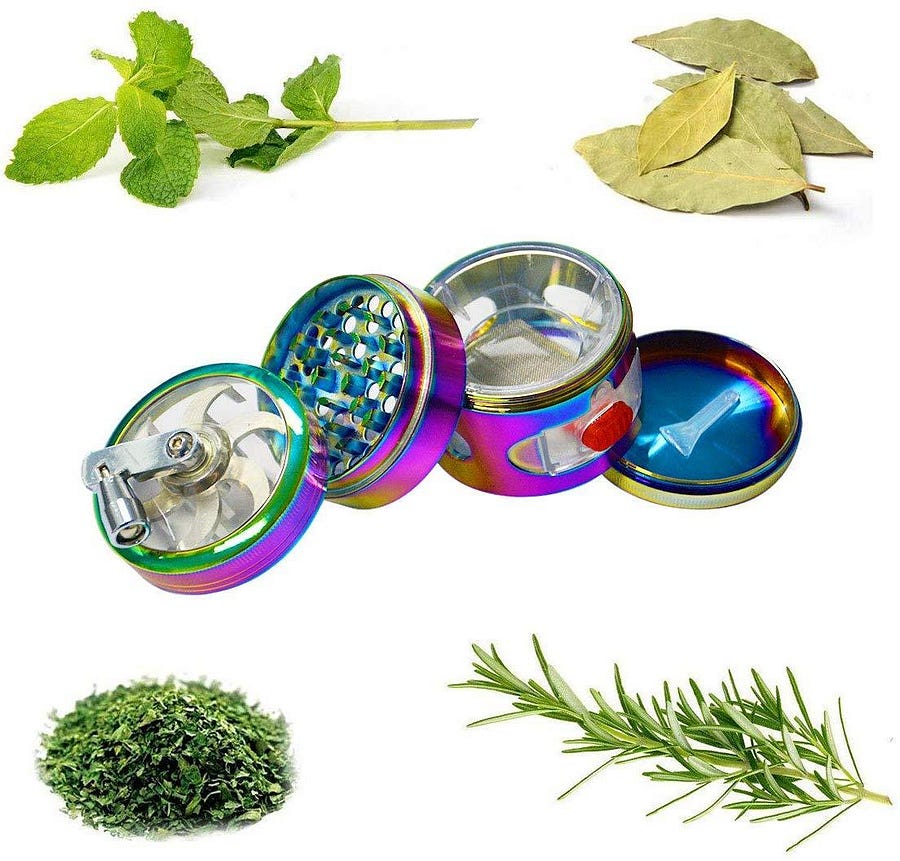
The Best Grinder For Plant Is …
Be it with joints, vapes, or edibles, a good grinder definitely helps create a better experience for the user. Not only does it convert buds into fine bits that can fit the bowl, it also aids in releasing the flavor and the active components of plants because it burns evenly.
There are many grinders available in the market to choose from, and each product has its own advantages. For a first-time buyer, this may feel a little bit overwhelming. When selecting one, it is essential to first get into the basic concepts and mechanisms of the device to understand how each could be beneficial. In the end, the best grinder for plant users is one that has the right balance of cost and functionality.
ECO Farm MB660 Foldable Grow Light Bar VS FloraGear FLORA X6 660w Full-Spectrum LED Grow Light
August 30, 2021
Plants need three things to thrive: soil, water, and sunlight. Soil and water are easy to come by, but if you’re planning to grow anything other than houseplants indoors, providing sufficient sunlight presents a challenge. Even if your house or apartment has plenty of windows, you likely won’t get sufficient sunlight to keep your indoor garden happy, especially during winter.
What is the light spectrum and how does it relate to my garden?
The electromagnetic spectrum is a wide range of frequencies of electromagnetic radiation. In Layman’s terms, there are invisible waves all around us with different sizes and speeds. These waves are so small that they are measured in nanometers (nm). A nanometer is one-billionth the size of a meter. Some more well-known parts of this spectrum include X-rays, microwaves, and radio waves.
One part of the spectrum that you may not realize is part of it is the visible light spectrum. This portion of the electromagnetic spectrum is the only part visible to the unaided human eye. These waves range from about 400 nm to 700 nm. The classic acronym “ROYGBIV” that was used to remember the colors of the rainbow can also be used to remember the order of the visible light spectrum. Red is at the upper end of the spectrum (700 nm), violet is at the lower end of the spectrum (400 nm) with yellow/green light in the middle (~550nm). You can use this information to better understand which light produces these wave frequencies in order to provide the correct color of light to your plant.
There are 3 main types of grow lights, compact fluorescent (CFL), high-intensity discharge (HID), and light-emitting diodes (LED).
Compact Fluorescent Lights (CFL)
Fluorescent lights (CFL) typically come in long, tube-like bulbs in a range of sizes including T5, T8, and T12. They are ideal for plants that require low to medium light, such as African Violets. When growing most houseplants, use light bulbs between 4000 and 6000 Kelvin, as the bulb’s color temperature will borrow from a full spectrum of colors — cools and warms. Culinary herbs, greens, and starter plants can be grown year-round with them. Houseplants that need lots of light, like cattleya orchids, succulents, and carnivorous plants, also perform much better under these full-spectrum lights.
Pros:
Inexpensive
Good for small grows
Available in many stores
Works in any standard light fixture
Available in various color temperatures
Good for beginner growers
Cons:
Low light output compared to other types of bulbs
Need to be close to plants
Need to use several
Not meant for bigger grows
Inefficient
Not for intermediate/experienced growers
High-Intensity Discharge (HID)
High-Intensity Discharge lights is a family of lights that produces light through an electric arc. This arc is formed when electricity is put into the bulb and it connects to both electrodes. This is different from incandescent bulbs as they do not require a filament to heat up to produce light.
The HID family can be broken down into two different types; High-Pressure Sodium (HPS) and Metal Halide (MH) lights. These lights both use the same principle, running electricity through an arc to produce light, however, they use a different substance in the arc to produce light. As the name may suggest, HPS lights use highly pressured sodium which reacts with the electricity to produce a red and orange color. MH lights use halides (such as Bromine or Iodine) and metals (such as Mercury) to produce a similar reaction, except this reaction produces blue and white light. Both of these lights can be expensive to purchase and operate, however, they are very efficient.
HID lights produce lots of light and the blue light of MH lights will promote vegetative growth, however, it also results in less flowering. The red to orange hue of HPS lights are powerhouses when it comes to producing buds and flowers, but plants will be less sturdy. Used in tandem, MH lights are often used to promote leafy growth before swapping in HPS lights to encourage plants to flower. It is also noteworthy that these lights need a significant warm-up time and it is not ideal to turn one on before letting the metal chamber fully cool down.
These lights are used by experienced growers, as many of them consider HIDs to be the best for growing and obtaining the highest yield.
Pros:
Costs less than other high-quality lights
Produces great results
Easy to set up and operate
Higher quality than normal incandescent lights
Cons:
Produces a lot of heat, requiring ventilation and exhausts.
Limited lifetime
Does not plug into a normal socket
Requires special hood & ballast
Needs significant warm uptime
Can significantly increase electric bill
Light Emitting Diode (LED)
LEDs are the new technology when it comes to grow lights. As technology advances these lights become more and more efficient for your plants. The lights emit virtually no heat and require a fraction of the power to operate compared to other lights. LEDs can be programmed to fully optimize the light spectrum needed for each of your plants, however, this can be very expensive to do. It is also important to know the difference between LED grow lights and regular LED lights. Regular LED lights are the kind you can find college kids using to make their room or car look cooler. LED grow lights will need a certain wattage (measurement of power) to produce certain brightness. The good thing about current-day LEDs is that the manufacturers often list the wattage in comparison to other types of lights, which can help a consumer make a better judgment on which specific bulb they should get so they do not make their electric bill skyrocket.
LEDs are able to produce enough light intensity for the most demanding grows, and the right LEDs can compete with or beat other types of grow lights. These lights can be both red/violet or white in color. Please be wary of cheap knockoffs that can be found all over the internet. Just remember you get what you pay for, so do your research and find the perfect one for you!
Pros:
The most energy-efficient grow light
Barely produces heat
Plugs into a standard outlet
Long lifetime
Cons:
High initial costs
Can be confused with regular LEDs leading to misinformed purchases
ECO Farm MB660 Foldable Grow Light Bar
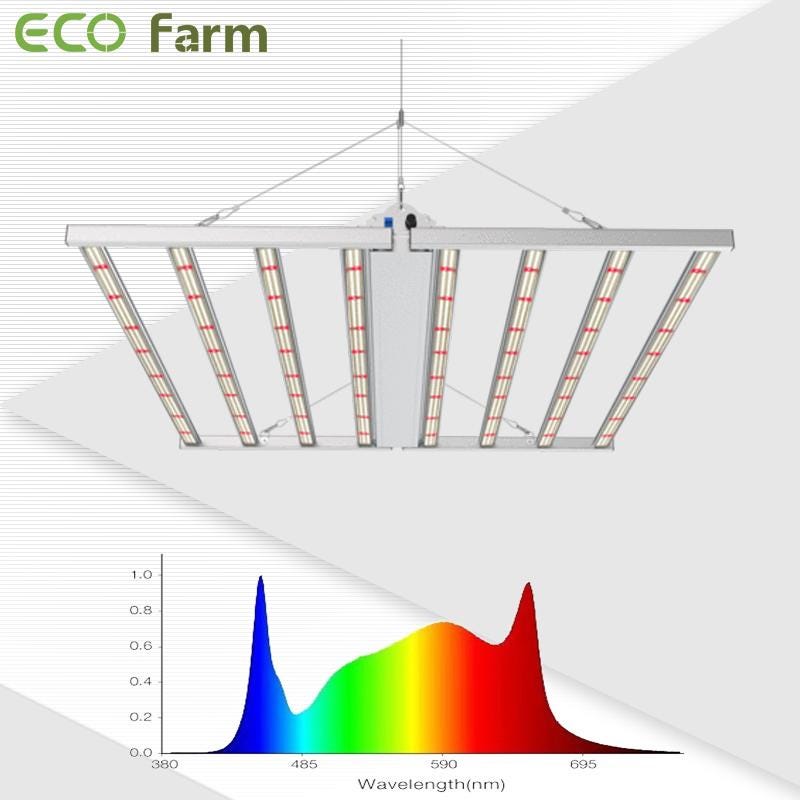
Features:
The ECO Farm LED Grow Light delivers growers and indoor gardeners the ability to stimulate pre-visibility, boost yields and increase quality all season long. The grow light utilizes Samsung LM301B chip design, to deliver spectacular PPF output up to 2.7 umol/J, The light intensity is higher, the light attenuation is smaller, and the lumen and PAR value are better than ordinary LED. It enables you to obtain a 30% higher output than HPS. This durably constructed LED grow light has 6 bar technology to deliver smooth, even light over the canopy. Remotely mounted driver technology allows for quicker and more efficient heat dissipation. In addition, the plant grow light uses an advanced waterproof power supply, installed in The outside of the lamp is easy to replace. This kind of growth lamp is a full-period lighting solution suitable for all growth environments (including humid environments) and is an ideal choice for greenhouse or indoor lighting.
Model: MB660
Wattage: 660Watt
Input Voltage: 100–277Vac
PPF:1757umol/s
Efficacy: 2.7umol/J
Dimming: 0–10V/PWM
PF: 90+
Lifespan: ≥50000 hours
Frequency: 50–60HZ
Beam Angle: 120
Warranty: 5 Years
IP Rating: IP65
Folding: Yes
FloraGear FLORA X6 660w Full-Spectrum LED Grow Light
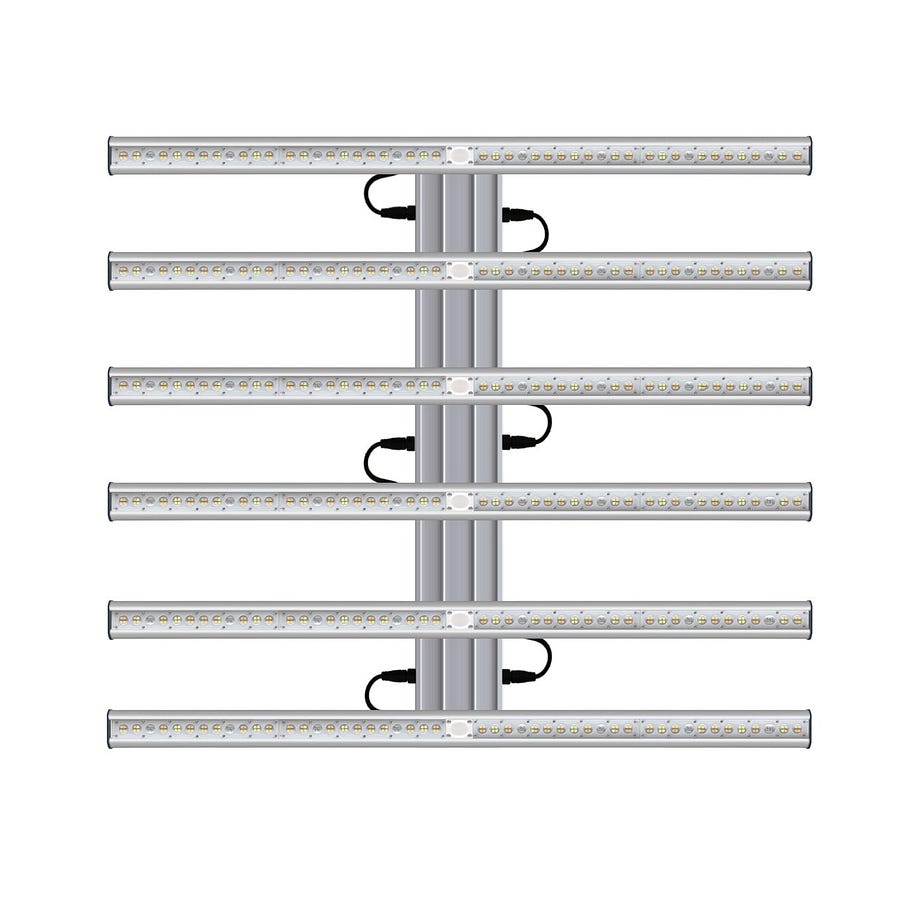
Features:
The full-spectrum LED light system for the serious grower, the FLORA X6™ features OSRAM LEDS and is ideal for flowering & bloom spaces up to 4'x4' or up to 5'x5' vegetation. Engineered for years of trouble-free operation, its full-spectrum light is strong and true. Can be part of up to a 100 light system controlled via an RJ14 hardwired network. Made to operate in damp spaces: a clear lens shield protects from moisture. 3-year warranty.
OSRAM LEDs
Inventronics 0–10v Dimmable LED Driver
Wattage: 660w with dimmer knob
Efficiency: 2.1 μmol/J
PPF: 1344 μmol/s
Input Voltage: AC 100–277v
3-Year Warranty
ETL-Certified
How to Use Lights for Plants Indoors
Supplemental light is usually essential for starting seeds indoors. Seedlings that don’t get enough natural or artificial light grow tall and rangy, with weak stems. To grow strong seedlings, the light should be placed close to the tray and raised as the plants grow taller.
Seedlings and mature plants growing indoors need more hours of light than you may expect. As a general rule, provide 14 to 18 hours of artificial light with a few hours of darkness each day. A timer set to turn on and off at specific times makes this lighting task easier.
Lights can also help gardeners in colder climates winter over outdoor container plants that wouldn’t otherwise survive frosty temperatures. Geraniums, Boston ferns, begonias, and other annuals can thrive indoors under lights, inside the home, or snug in a garage or outbuilding where they can be kept from freezing. Here, too, a timer can turn the lights on and off automatically. Plants in the potting mix under lights may dry out more quickly, so don’t forget to water those containers that are wintering under lights but out of sight.
Conclusion
Our favorite grow light was the ECO Farm LED Grow Lights. It works really well in compact spaces, and even with its remarkably affordable price includes a bunch of convenient features. Not to mention, it provides a full spectrum of light so it can nurture plants throughout their different stages of growth.
Of course, if another light stood out to you because of your specific needs and situation, then go with that one. You’ll be happy with whichever one you choose.
SunStream Air Carbon Filter for Inline Fan VS VIVOSUN Air Carbon Filter for Grow Tent
August 28, 2021
What is the best carbon filter?
If you’ve clicked on this article you’ve probably been asking yourself that very same question, or even, is it even necessary to incorporate a carbon filter into my grow room?
Well, the chances are you want to keep your grow room discreet, as well as odorless, which in turn will not only keep YOU happy, but most importantly your NEIGHBOURS happy, and hopefully unaware…
Maybe your grow operation requires a 4–6-inch carbon filter? What about an Aluminum or steel frame? What about the flange, mesh, or CFM!
As you are probably already aware, these features and more all play a big role in the performance of your carbon filter. Regardless of if you use it in a grow tent or full grow room.
So If you’re looking to learn a bit more about carbon air filters or maybe searching for the best carbon filter for your grow room, then keep on reading.
What is Carbon Filtering?
Carbon filtering is a method of filtering which is used to remove contaminants and impurities from the air, using a chemical adsorption process. A bed of carbon is used within the carbon filter to achieve the required results.
A single particle or granule of carbon provides a big enough surface area or pore structure to expose the contaminants to the active sites. Just one gram of activated carbon is thought to have a surface area in excess of 3,000 m2 (32,000 sq ft).
Air carbon filter odor control is known to work via a process called adsorption, whereby contaminants and pollutants in the air are captured and treated inside the pore structure of the carbon substrate.
Activated charcoal carbon filters are extremely effective at removing particles, odors, and such from the air, so are ideal for most indoor grow rooms or grow tents.
How to Choose the Right Carbon Filter Size
Choosing the correct size carbon filter is not random. You have to apply a simple formula that we explain below:
First, you have to measure your grow tent’s volume with this easy equation:
volume = length x width x height .
After you have measured the volume we have to talk about the “CFM” which stands for cubic feet per minute. This tells you how much air in cubic feet the filter can clean each minute.
To determine the CFM, divide the grow tent volume by 3.
With this information, you can determine the size of the carbon filter you need.
Grow tents with less than 400 CFM a 4-inch filter is needed
For tents of 400 or more CFM, you can use 6-inch liters
And finally, for grow tents of 700 CFM or more, you should use an 8-inch filter.
SunStream Air Carbon Filter for Inline Fan
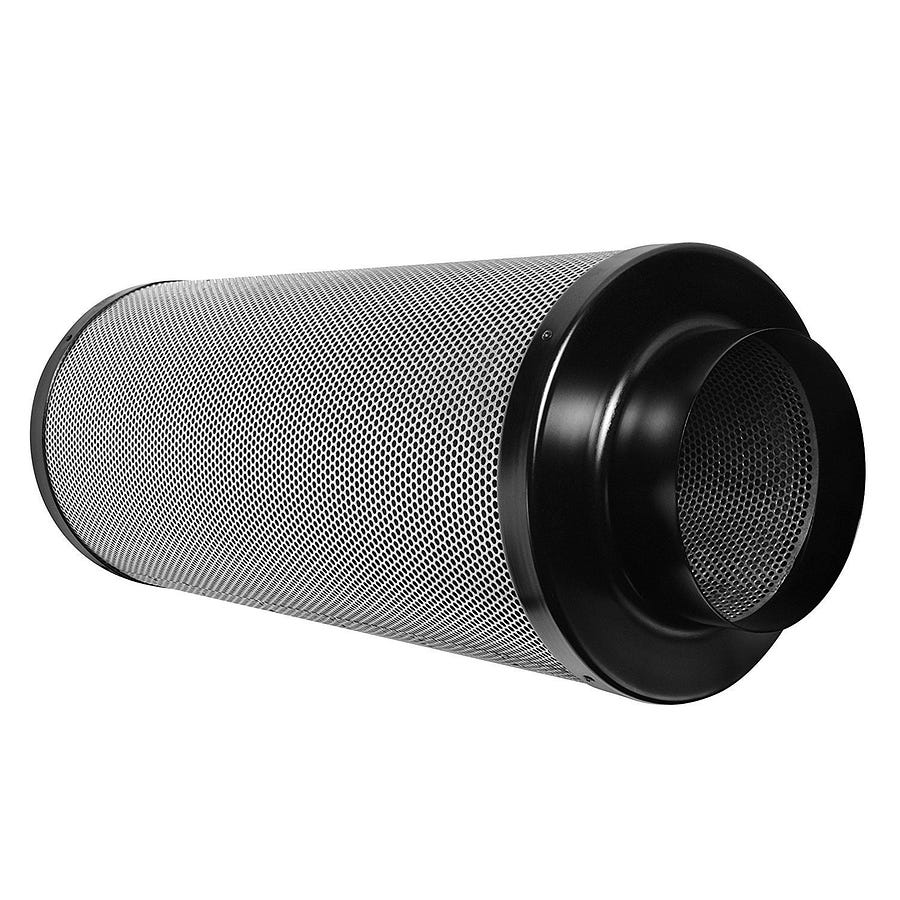
Features:
To manufacture Sunstream Carbon Filters The carbon filter uses the top-grade RC-48 Charcoal Carbon from Western Australia. The carbon Bed in the filters is 38mm thick and machine packed with extremely small granules. Sunstream Carbon Filter is designed with years of growing experience in mind. The Carbon Filter combined with a proper fan will eliminate the odors in your flower room or grow tent. This Carbon Filter can help you filter out cigarette smoke, plant-based allergens, and mechanical or any other foul smells at your house, workshop, commercial space, etc. 1.5inch carbon bed, Effective for up to 24 Months Of Use.
VIVOSUN Air Carbon Filter for Grow Tent
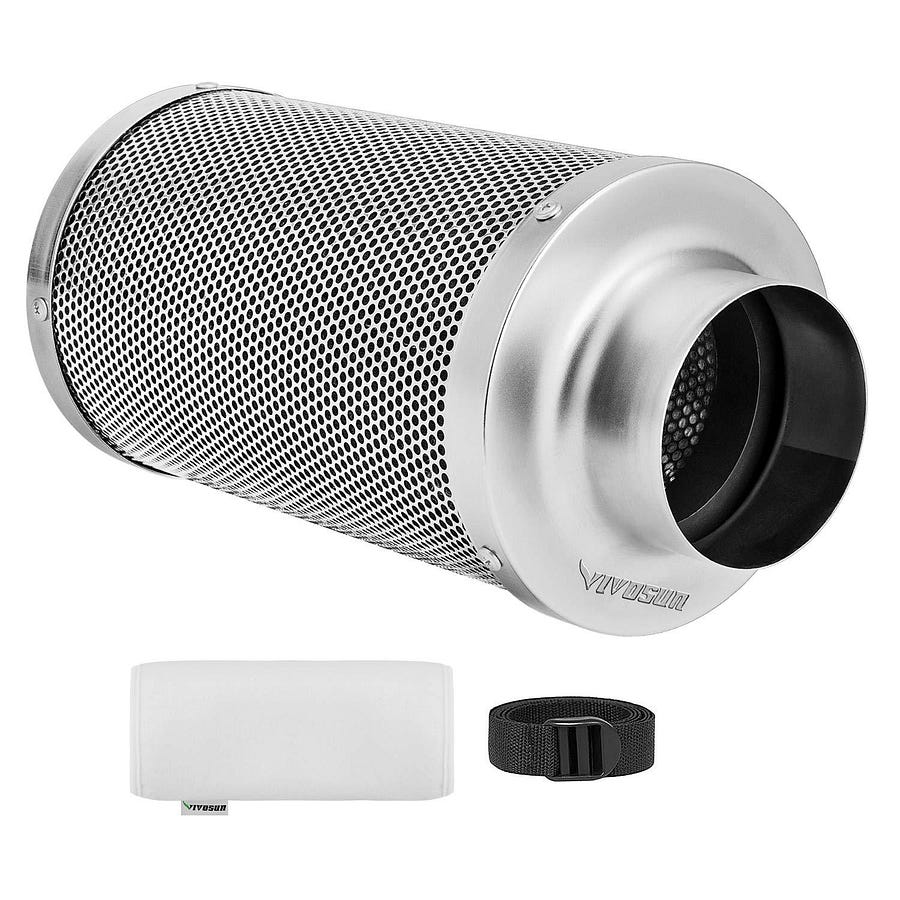
Features:
Made of imported Virgin Australian activated charcoal, delivering 100% filtered airflow. 1050+ RC 48 carbon captures three times more air contaminants than average due to the optimal surface area per carbon particle. Protects from chemical irritants and eliminates odors- from pungent indoor grow operations to bathrooms, basements, and kitchens. Absorbs odors from pets and smoking as well. Eliminate some of the most undesirable odors, pungent smells, and particulates from indoor grow tents, hydroponics grow rooms. Item can be used as intake or exhaust filter in a variety of setups including use with a 6-inch inline fan and duct fans, intake and exhaust fans, air exchange fans, ventilation ducts, and other accessories.
How Long Does Carbon Filter Last?
A Carbon water filter lasts around a year. On the other hand, a carbon air filter lasts somewhere between six to 12 months.
The life of a carbon filter depends on how a carbon filter works.
You may compare a carbon filter to a sponge. Carbon Filters, too, comprise an area with zillions of small pores. However, they adsorb the contaminants instead of absorbing them.
Carbon Filter Lifetime Determining Factors:
Here are some factors that determine the lifetime of a carbon filter.
1. Quality Of Carbon Factor
Dealers sell carbon by its weight; heavier weight means effective carbon and long life. Even a carbon filter is rated by the quantity of activated carbon it has.
However, sometimes, air cleaners contain a higher weight of carbon in a filter.
Anyways, the weight of the carbon decides the duration of a charcoal filter lifetime.
2. The Size of the Filter And Room
If you use a small filter in a large room, expect your filters to get dirtier fast. Filters made for a 100 sq. ft area won’t function the same in a 200 sq. ft sized room.
They won’t perform well and last longer due to the volume of air passing through the filters.
A suitable filter in an appropriate room size will have an impact on the carbon filter lifespan.
3. Pollution
Lastly, if you use carbon filters in dusty areas, expect them to have shorter lives and get clogged.
Conclusion
Choosing the best carbon filter for your grow room isn’t hard, but it is important. Here are three things to keep in mind:
Your carbon filter needs an inline fan that can direct air into the filter for purification, so make sure your fan and filter are compatible.
Many carbon filter companies have their own fans that you can buy separately. If you don’t buy a combo fan and filter, try to get a fan and filter from the same company.
Carbon filters don’t last forever, so take care of them.
If you have any questions about choosing the best carbon filter for grow room use, comment below!
NugSmasher Pro Touch 20 Ton Manual/Pneumatic Rosin Press VS Master Press Programmable 20 Ton Dual Heated Plate Pneumatic Rosin Press
August 27, 2021
Electric rosin presses are the least common in the market but are quickly becoming more popular. The advantage of an electric press is the simplicity of use. With an electric rosin press, there is no need for hand cranking or pumping, only the push of a button or flick of a switch.
Electric rosin presses are generally less powerful than hydraulic or pneumatic presses, which make them more suited for personal use. Although, a bit less powerful they are the quietest operating rosin presses.
Electric presses can also be considered hybrid as most use hydraulic rams, ball screw actuators, or something proprietary, to generate pressure. However, most people refer to them as merely, electric rosin presses.
How do you make rosin from the rosin press?
Extracting rosin from the rosin press is very simple. It does not require you to spend a fortune. There are many brands offering high-quality equipment to make rosin.
The production of rosin requires you to employ a reasonable rosin press, raw material i.e. flower, filter extraction bag, and parchment paper. However, there are other factors too that play a major role in the extraction of rosin i.e. adequate heat, pressure, and time.
Which rosin press should you buy?
There are various factors that should be considered while deciding about the best rosin press to buy. These factors include the purpose, demand, space, convenience, and so on. However, determine the answer to the following questions to understand these factors in black and white.
What is the purpose of buying the rosin press? Are you going to use it personally or for commercial purposes?
How much oil do you want to extract?
Do you want compact and handy equipment or the hefty one?
Types of Rosin Presses
Rosin Presses are available in different types. Let’s dive into some of the details.
DIY Heat Plate Kits
DIY heat plate kits are suitable when you want to make your own rosin press. The Rosin press is a simple instrument so you can put it together yourself. What you really need to buy is the hydraulic shop press, heating plates, and a controller to adjust the temperature.
Manual Rosin Press
Manual Rosin press is very simple equipment that is equipped with a pull-down lever a requires you to put pressure in order to produce rosin. The hand-crank device is easy to use and produces good quality rosin without investing a fortune.
Hydraulic Presses
Hydraulic presses are equipment that uses hydraulic pressure to extract rosin. The pressure is created with the help of a manual hand-crank pump. The hydraulic presses are affordable and simple. They are the best entry-level pressing equipment. The variable hydraulic presses are also available. These equipment employ hydraulic cylinders while externally they are operated by a foot pump. They are large and hefty, produce more pressure, and have the capacity to serve commercially.
Pneumatic Presses
Another efficient type of rosin press is the pneumatic press. This equipment is operated by the air compressor. They produce great pressure just by putting in a small effort. This equipment is sturdy and long-lasting. They serve commercially very well because of the accuracy and efficiency they offer. However, the air compressor makes a loud noise that feels irritating to some users.
Electric Presses
Electric Rosin presses are a modernized form of rosin presses. They are getting popular day by day due to the convenience they provide. These presses do not require an air compressor or external pumps but just an electricity outlet. The advantages of the electric press outweigh the downsides which are negligible. They are compact and portable. You can easily take them anywhere with you. Moreover, they don’t make a noise like the conventional heavy-duty units. So, they are the reliable choice for most commercial users.
NugSmasher Pro Touch 20 Ton Manual/Pneumatic Rosin Press

Features:
NugSmasher rosin press has the muscle of the NS Pro with a new Interactive Extraction Brain. The Interactive Extraction Brain consists of a powerful computer that is made to grow with an updateable interface through wireless connectivity along with a 10.1" interactive color touchscreen display! NS has some amazing tools coming out in the near future that this system is designed to work with. The Pro Touch has a powerful (and easily) applied 20 Tons of controlled pressure with 3 types of precise digital PSI reporting an automatic extraction timer and a surface area calculator for target pressure. You can get started immediately with hand operation, like all the other NugSmasher presses.
Master Press Programmable 20 Ton Dual Heated Plate Pneumatic Rosin Press
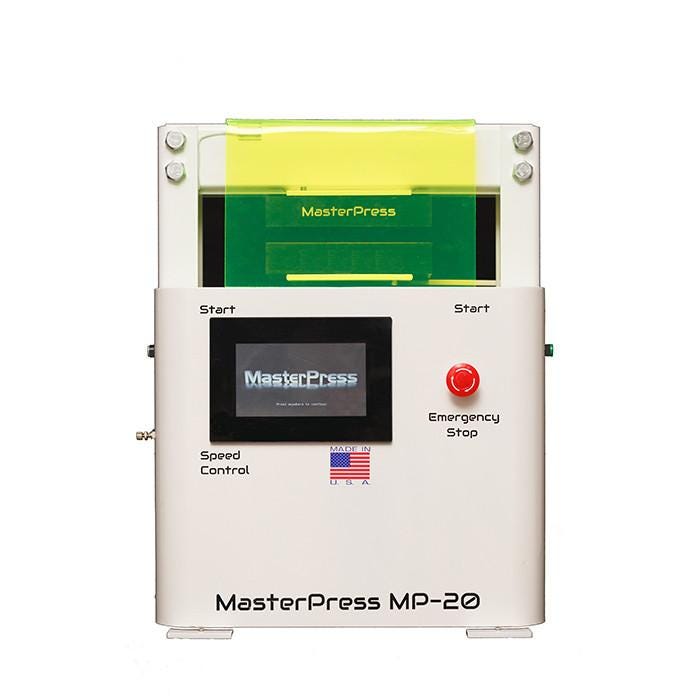
Features:
The Master rosin press features 6x8” plates to press up to 1–1/2oz of flower and or larger quantities of bubble and kief. Safety is a key feature of the MP-20, Osha type of switches require both hands to start the press. There are 30+ profiles that can be saved and an import/export for backup. We have a manual mode to input profiles by screen and fine-tuning in the manager section. Touch screen interface controls both plate temps and Pressure ramp/soak profiles. 30 profiles with 10 sections each. 20 tons of programmable pressure in seconds for timing amping/soak profiles or manual control. The desktop format requires an air compressor ( 100PSI min.)
Things to Consider
Remember, no two rosin presses will offer you the same quality. Each rosin press carries different properties and features that enable it to produce unique results.
So, before clicking that buy now button, you must research and figure out a few things to make a better decision.
First, identify the purpose of the purchase. Why are you investing in a rosin press? Will you use it for personal purposes or commercial production?
Next, estimate the hours that you will use the machine. However, do not forget to consider some rosin quality relevant factors too.
Depending on all of these, you will select an idealistic rosin press that suits your specific needs the best.
Design & Build
The structure and construction of the rosin press matter a lot too. Aesthetics are something you would not evaluate in a rosin press. Instead, you would focus more on the hidden aspects.
For example, if you’ve limited space in your office, you need to consider the dimensions and measurements of the machine.
If you’re going to place the rosin press on a desk, then you need to consider its weight and the desk’s compatibility. Can the desk even support the weight, or you need to make separate arrangements?
Some people shift places a lot, or they simply prefer working in various places. In such cases, one should examine rosin presses with a more portable and easy-to-use build.
Heat Plate Quality
Heat and temperature play a very prominent role in quality rosin manufacturing. Poor heat can deteriorate the end-product quality and make results non-uniform.
So, to ensure the best only, you should be vigilant about heat plate quality. Heat plates conduct the heat across them. It is where you place the buds. The machine presses these heated plates, producing rosin.
Technically, rosin presses have either square plates or rectangular ones. Rectangle plates that are long and narrow produce idealistic results.
The maximized parameters and thinner profile lead to better yields. It also creates more potent and high-quality rosin.
Heat plates should also have uniform heat distribution so that the plants compounds melt to have lower viscosity.
A rosin press that allows you to have more control overheating and temperatures can help produce rosin with different viscosities.
Capacity & Yield
Different rosin presses have different capacities and yields. You must select one depending on the amount you want to produce.
Typically, a rosin press will produce rosin anywhere from a few grams to several pounds. If you manufacture rosin commercially, then opt for the highest capacity possible.
Also, purchase rosin presses that promise a minimum of 20-percent yield (with 35-percent being the ideal). Below this, your yield would practically be useless.
Brand & Budget
High-end rosin presses can come anywhere between 500 to 1000-dollars. That’s a lot!
Well, the rosin press is a gadget. And, the more you will pay, the better quality you will get.
However, it doesn’t mean you won’t find a quality rosin press at budget-friendly rates. Research and patience are all you need to find the idealistic pick without spending all of your hard-earned money.
Conclusion
Nowadays, when the market is flooded with varying equipment, it is confusing to get the right equipment, so we brought to a list of the best Rosin press helping you to make the right decision. We hope you would like our collection and definitely add one to your cart.
Let us know about your experience in the comments section below and share your reviews.
MAXSISUN 2-in-1 Grow Tent 600D Mylar Hydroponic Indoor Plants Growing Tent VS MARS HYDRO 60"x48"x80" Grow Tent 5x4ft 2-in-1 Grow Tents
August 26, 2021
Unlike in the past, people no longer need acres of space to grow food for their homes. With the development of grow tents, many people can now grow plants in a tiny 4×4-foot space. The enclosed nature of these grow kits prevents pests from invading and damaging plants. Finally, you can set up an irrigation or lighting system in one to maximize the growth of plants. If you are tired of buying vegetables you can grow easily.
What is a Grow Tent?
A grow tent is a prefabricated growing environment for plants. Grow tents are made from steel poles that build the framework and then wrapped around by a heavy light proof and smell proof canvas. You can then hang your light and other important elements such as a fan and scrubber inside of the tent to help improve growing conditions. Grow tents allow you to control light cycles where you would otherwise not be able to in a standard greenhouse.
How to Use a Grow Tent for Beginners
Using a grow tent is simple:
Set up the metal pole framework for your grow tent.
Wrap the canvas around the tent and zip.
Hang your light from the top poles with ratchet strings.
Connect a fan with a scrubber inside the tent for airflow and smell.
Place your plant inside the grow tent.
How to Clean a Grow Tent
Cleaning a grow tent is extremely easy:
Unzip your grow tent.
Turn off lights and unplug all accessories.
Remove plants from the tent (if you have a trellis in place then you will not be able to do this).
Spray Green Clean everywhere inside the tent and scrub with a washcloth (eliminate pest).
Spray with Disinfectant and scrub clean with a new washcloth.
Let your grow tent dry for 30 minutes.
Return plants and accessories back to the tent.
MAXSISUN 2-in-1 Grow Tent 600D Mylar Hydroponic Indoor Plants Growing Tent
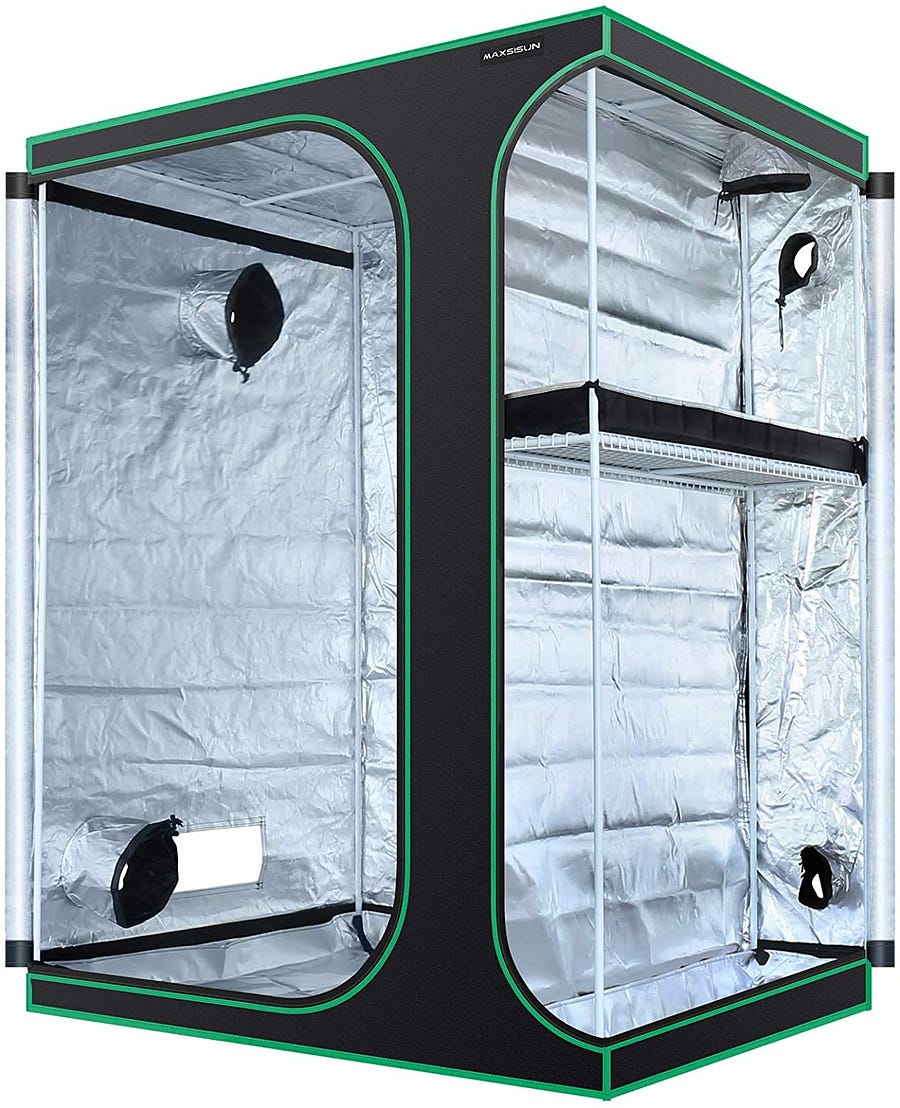
Features:
The MAXSISUN grow tent with two Independent spaces, 48x48x80" 1PC Master-Room for Vegetative/Flowering, 12x48x80" 1PC Baby-Room for Germination. two-room separated by a removable mylar baffle. Don’t worry about strong light drying the seedlings, Space communication can share a set of heat dissipation equipment. The tent is made out of tear-proof 600D thick waterproof oxford cloth and supported by a Metal tripod, 3 hanging bars can bear 120LB far enough for a hanging light system and other equipment. The tent can be very easy to install even if it is your first time and just yourself. SEAL ALL LIGHT. With extra-thick canvas, heavy-duty zipper, and double stitch guarantee the tent blocks all light from escaping. On the interior, a 100%-reflective mylar lining makes your lighting set up more efficient at any power configuration.
MARS HYDRO 60"x48"x80" Grow Tent 5x4ft 2-in-1 Grow Tents
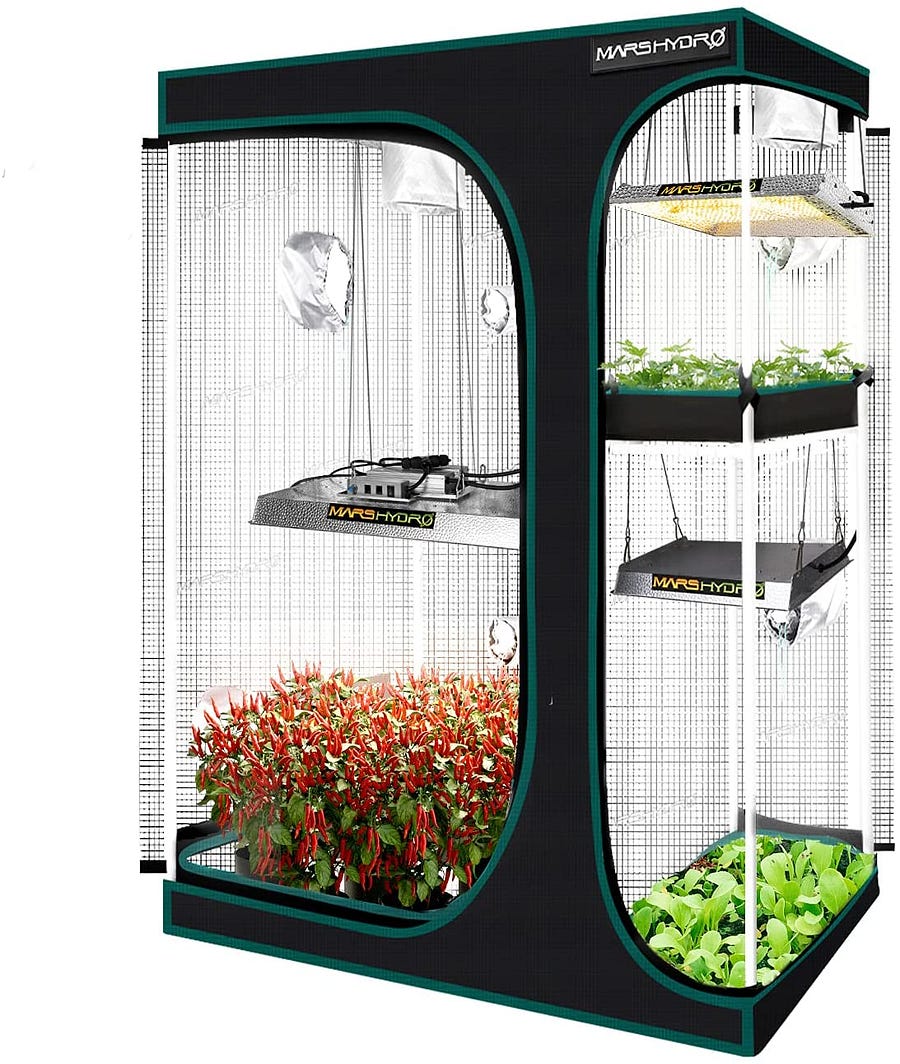
Features:
The Mars Hydro Grow Tent provides protection for specialty plants that need a closed environment for peak development. Using 1680D reflective fabric, all-metal poles, and sealed seams, expert gardeners have created a durable structure that’s built to last. 2-Tier 12"x48" Small Grow Tent (Perfect for propagation & seedlings) + 48"x48" Large Grow Tent (Perfect for plant grow taller, flourish & florescent. Heavy-duty 600D lightproof oxford cloth and diameter 16MM white paint coated metal rods and Large heavy-duty Zippers. You can grow seedlings at the 2-tier small tent, and transfer them to the larger tent after they grow taller. Rectangle vents with mesh for better ventilation and multiple vents for fan and filter output.
How to Choose the Right Size Grow Tent?
When it comes to gardening, there are a lot of things to consider. There’s the location, maintenance, soil type, climate, right size or containers, and of course, space. Space is really important in starting a garden. If you think that your backyard is lacking in space, don’t worry there is an alternative way to raise a garden. Indoor gardening can provide many more benefits than an outdoor garden.
You can choose between a grow room and a grow tent depending on your needs. But, if you’re looking for a more cost-effective option, we recommend a grow tent. Purchasing a grow tent can save you some money and space. You can find it in various sizes from physical and online shops that will surely fit inside your small house.
Another thing you need to consider when purchasing a grow tent is how much space do you have. The cost depends on the size that you choose. However, each model still provides different features that can help you. Having a high-quality grow tent allows you to control and keep the environment contained. So, here are the sizes you can choose from:
Small Grow Tents (2x2ft — 3x3ft)
These sizes are perfect for beginners and for people who have limited work areas. In a 2’x2’or 3’x 3’ grow tent you can only put 2–6 small plants. It is great for mother plants.
Medium Grow Tents (4x4ft — 5x5ft)
These sizes are the most popular tent sizes. In a 4 x 4ft tent you can raise 4–6 plants while in 4 x8ft or 5 x5ft tents you can put 4–10 plants.
Large Grow Tents (6x6ft — 8x8ft)
These sizes are for people who have large spaces and harvest in their house. In this kind of grow tent; you can raise 14 up to 24 plants. It is enough for you to cultivate a vegetable garden.
Regardless of how many plants you aim to raise, make sure they fit perfectly. There should be enough space for every plant to grow and not squeezed like sardines.
What Makes a High-Quality Grow Tent?
If you still are unsure what grow tent to get, then I highly recommend you read the section below to understand what features to look for in a tent, and why it matters when it comes to real issues a plant grower may run into. With a solid understanding, you can go out and try to find a tent that best suits your needs.
The Frame Work of the Grow Tent
In reality, I have more than 10 years of experience with grow tents, back when grow tents were made very cheaply I was in the mix. I have dealt with grow tents where the metal joints did not snap together well or were near impossible to take apart. You want to get high-quality steel bars that snap into place. If the steel bars connect poorly then you will notice a wobbling in your tent. Often times you need to slide the grow tent around (smaller sizes) to access all sides of the tent. Having a strong frame is important for the longevity of the tent. Make sure the metal attachments lock into each other instead of just sliding in with nothing to hold it but pressure.
The Quality of Fabric Determines the Best Grow Tent
The stitching of the canvas of the grow tent is important. If your tent’s fabric is very thin then you are prone to more light leaks and smell leaks. 2021 most grow tents are heavily made and Gorilla tents are even double layer. It’s hard to tell from pictures but you want to make sure that the grow tents are at least mentioning that their canvas is stitched for no light leaks and smell proof. Read the reviews to see customers showing pictures of light leaks or making claims of smell leaks. If there are one or two people I wouldn’t worry, but if all the reviews are claiming this then you will want to avoid that grow tent.
The Best Grow Tent has Great Functionality and Features
Functionality is important. Most grow tents these days come with amazing options in the way they set up the tent. For example, Gorilla offers many “ports” at the top, side, and bottom, for you to run carbon filters, fans, PVC pipes, and even running your wand to feed inside of the tent. Not only that you want to make sure that the top steel bars are reinforced with an extra crisscrossing of bars so you can hang very heavy lights and scrubbers at the top.
The Add On’s a Grow Tent Allows
A grow tent is premium or considered high-end when it also allows for add on’s. Things such as extending the top for taller plants, or using the inside steel bar framework to hang a trellis (SCROG net). There are various attachments such as fans and ratchet strings that allow you to customize carbon filters and light levels.
Conclusion
Our world continues to evolve and embrace innovation every year. Thus, it is an advantage to invest in up-to-date products that will utilize your skills as a horticulturist. If you’re just starting and you want to seek the best grow tents, this review can help you. Remember, it is essential for your plants to grow in a tidy environment. With enough research, rest assured that all the grow tents in this review come from reputable manufacturers. So, be sure to follow us to stay updated about the latest reviews of the grow tents.
